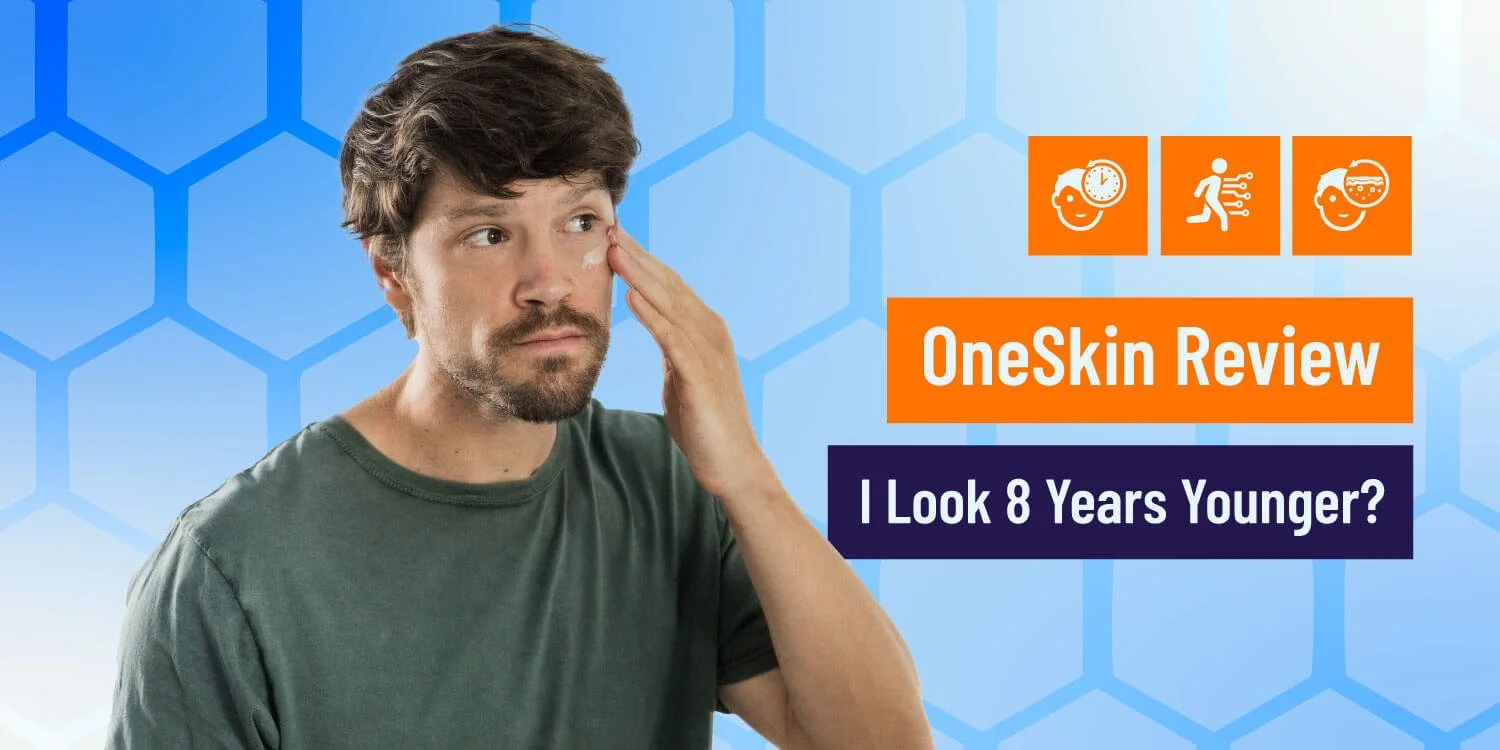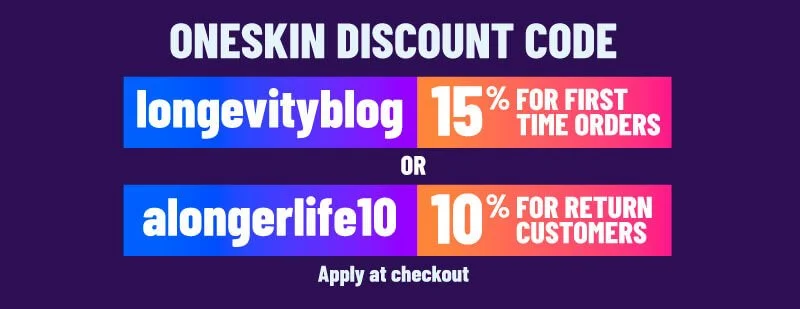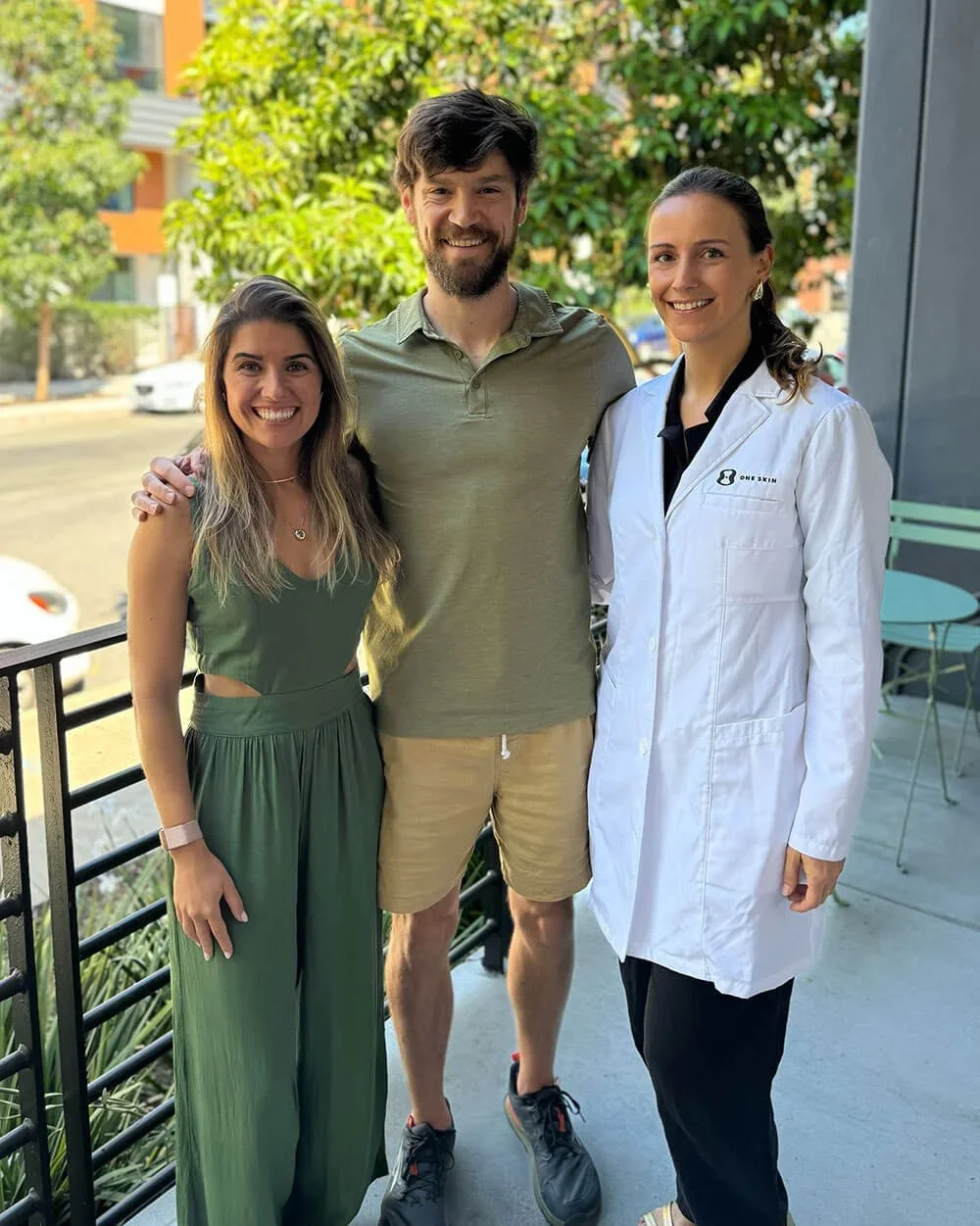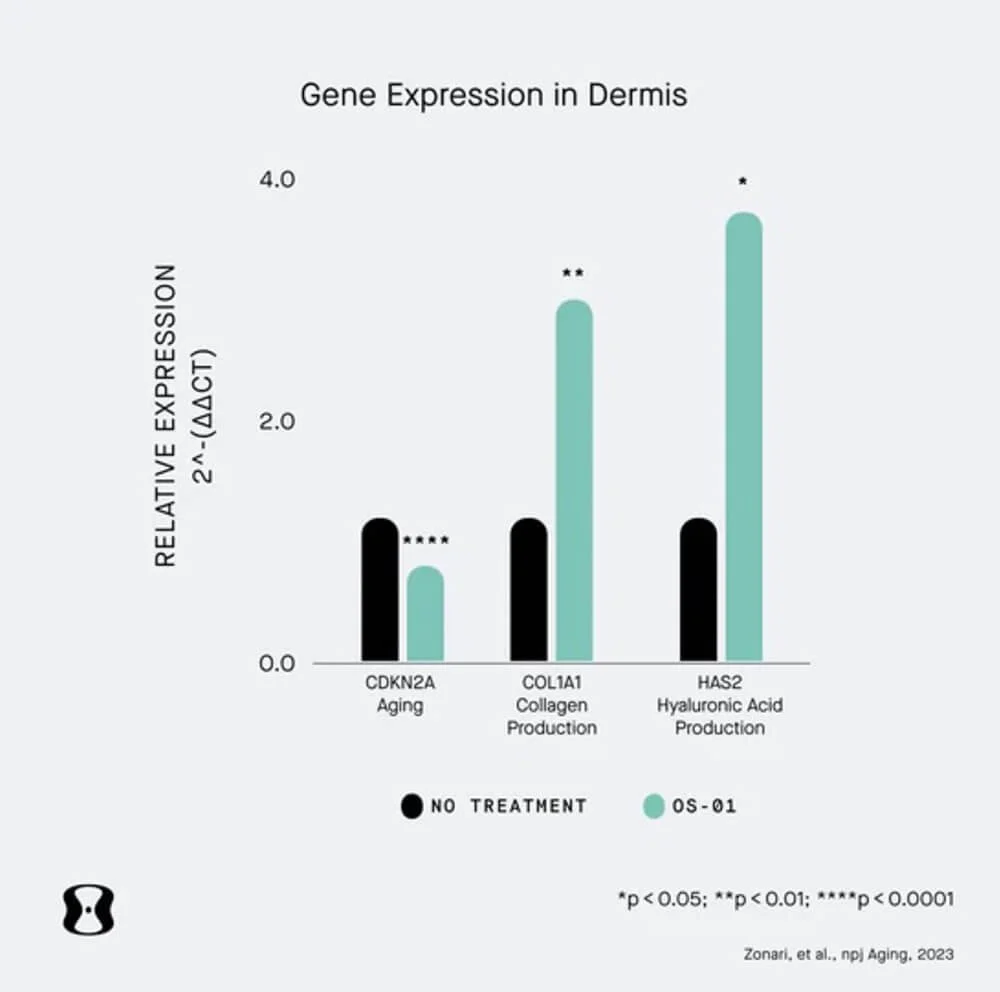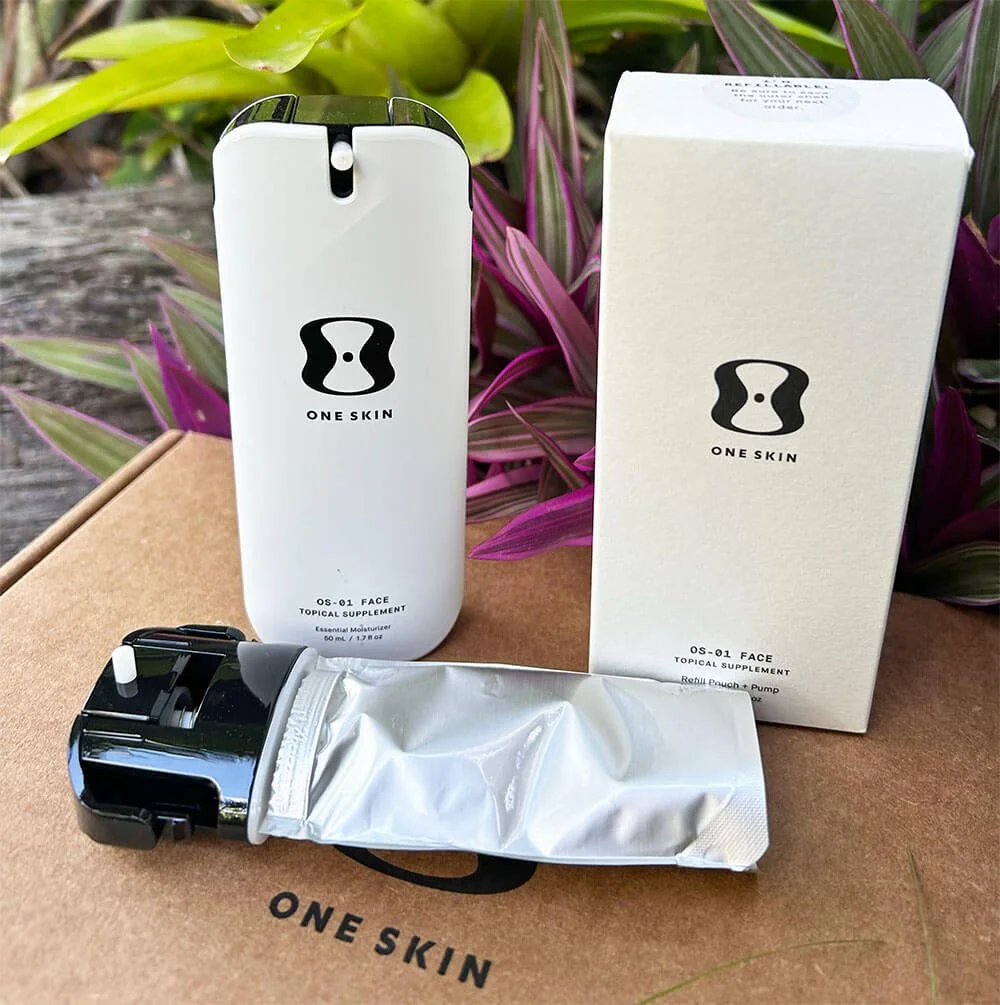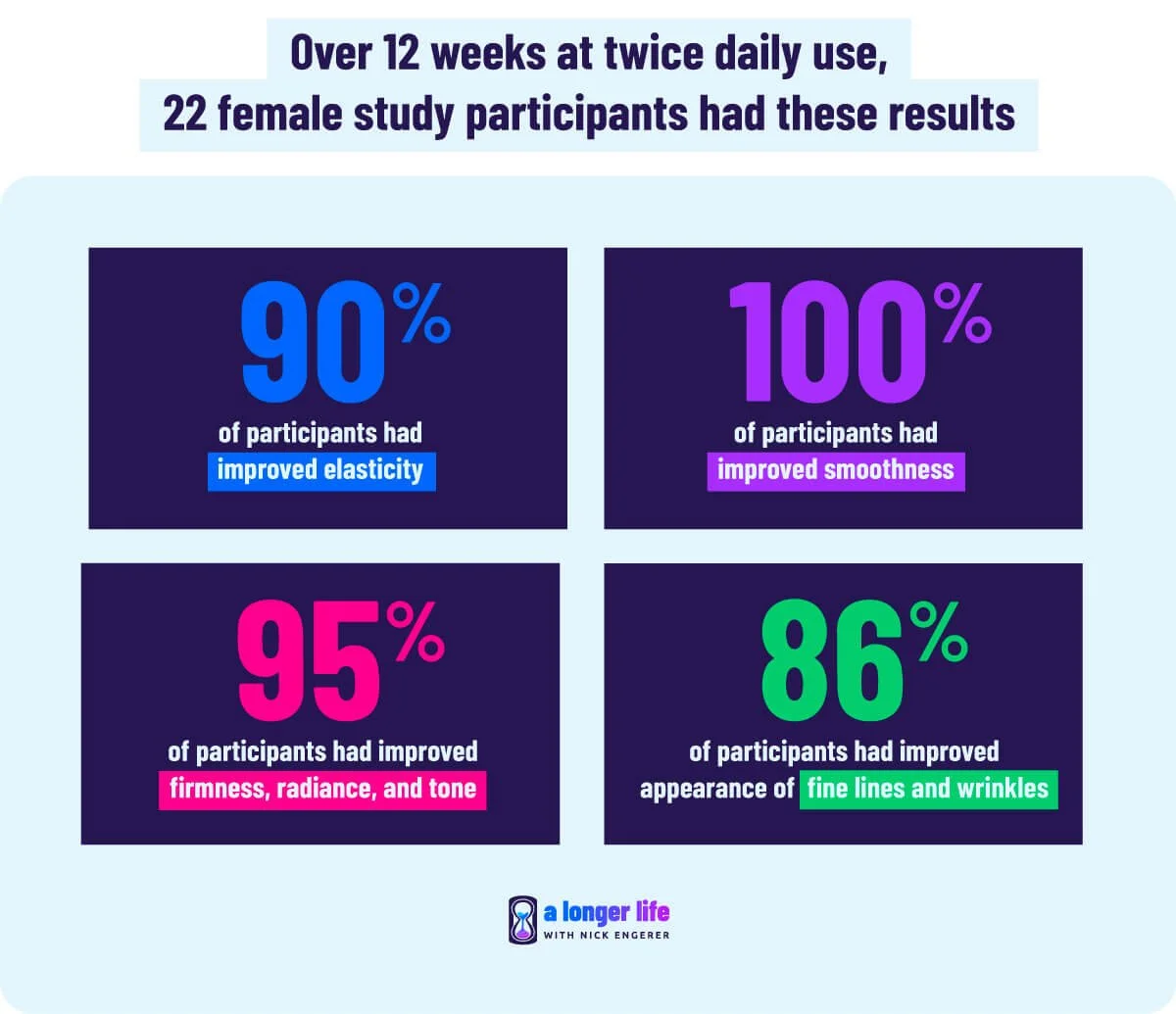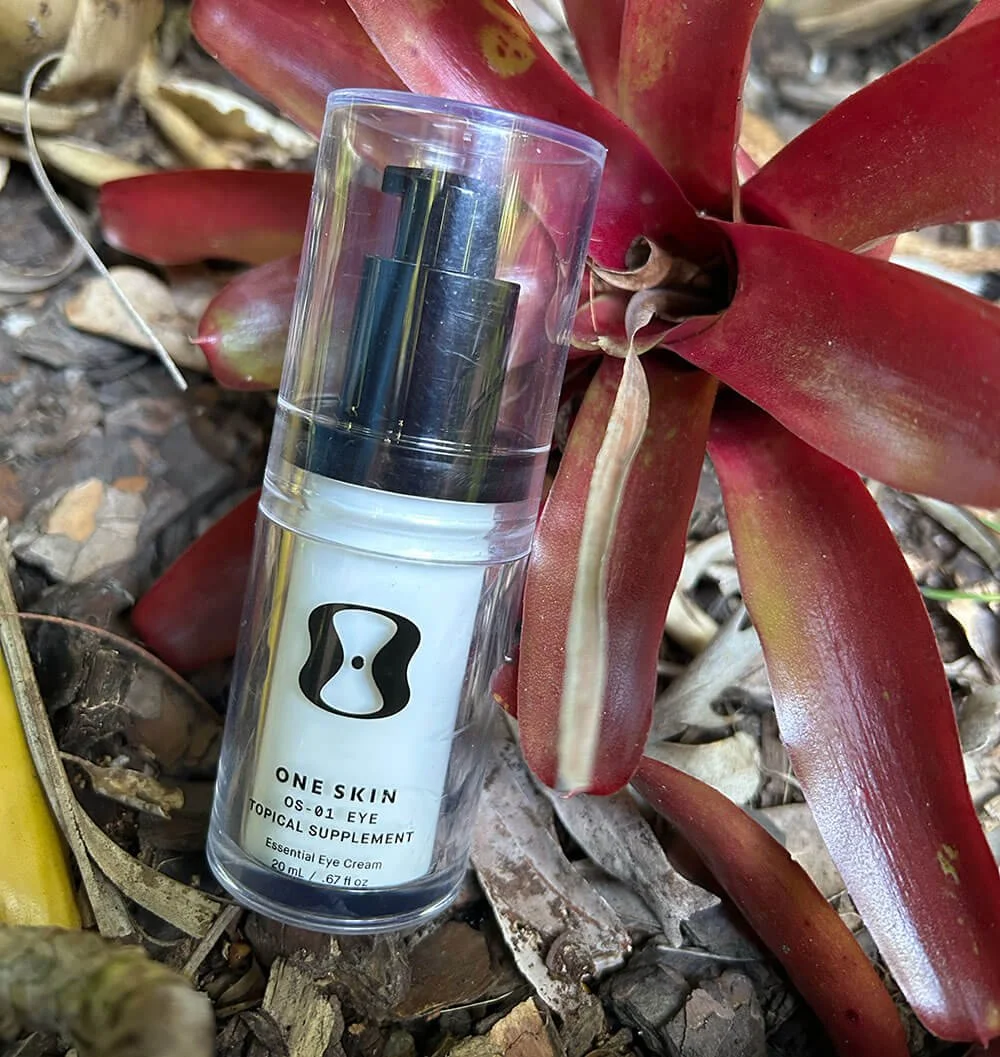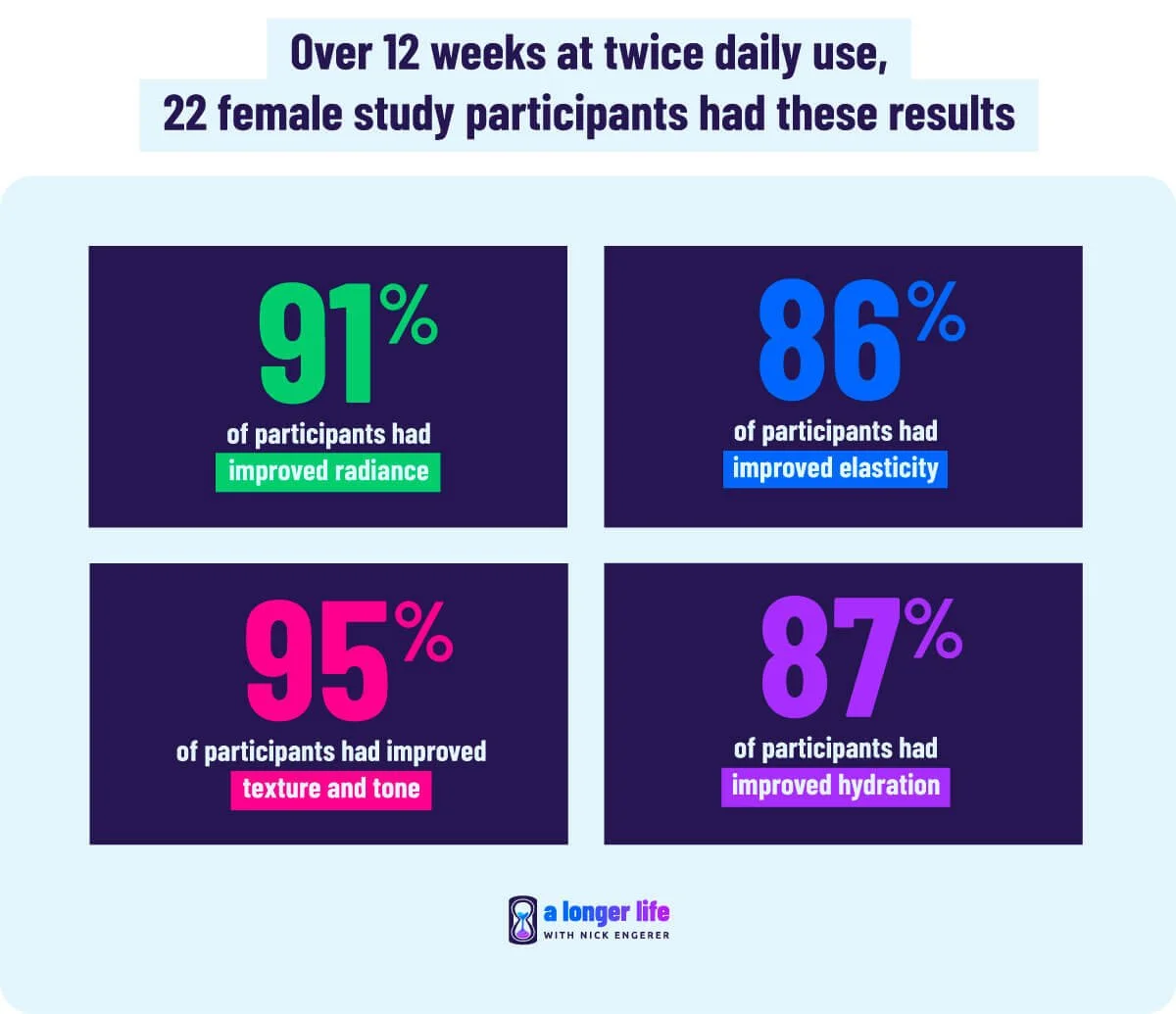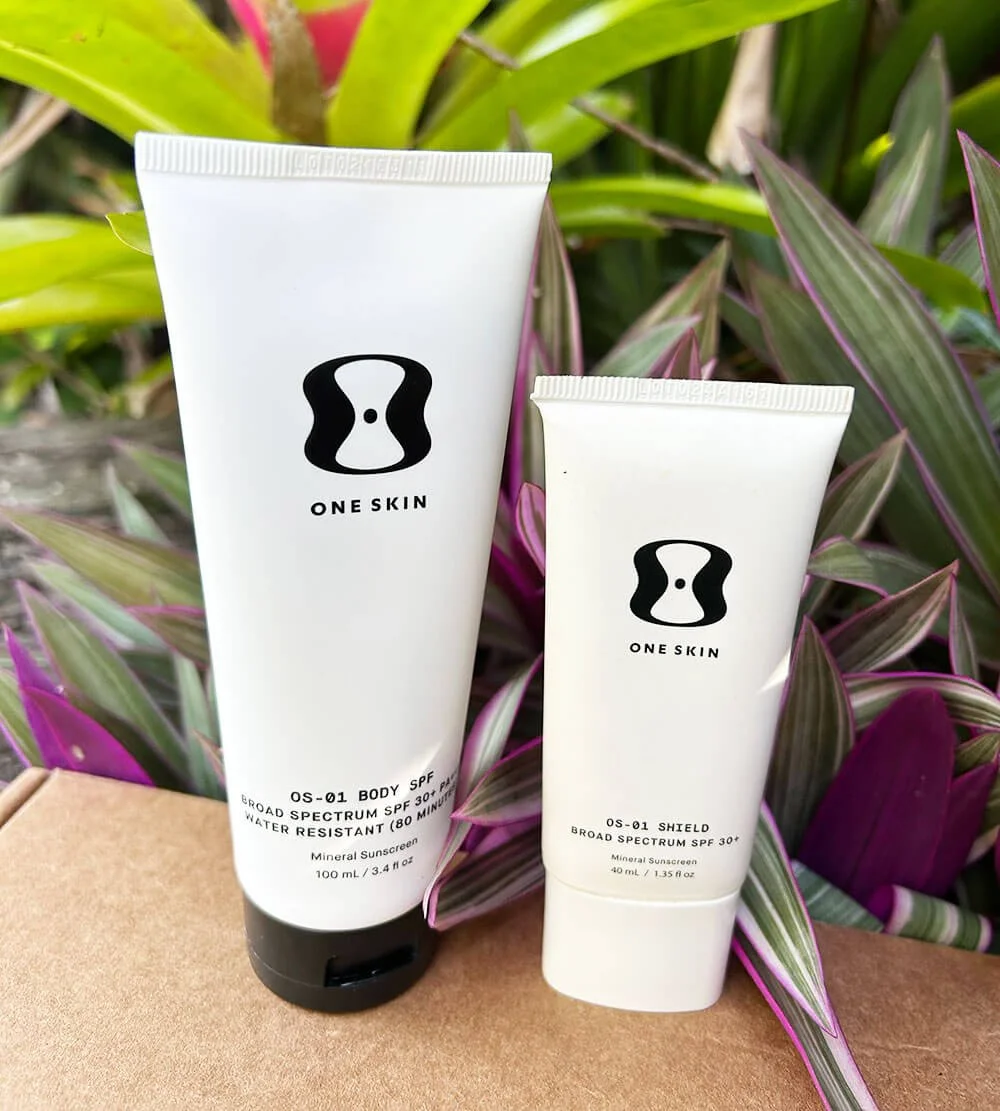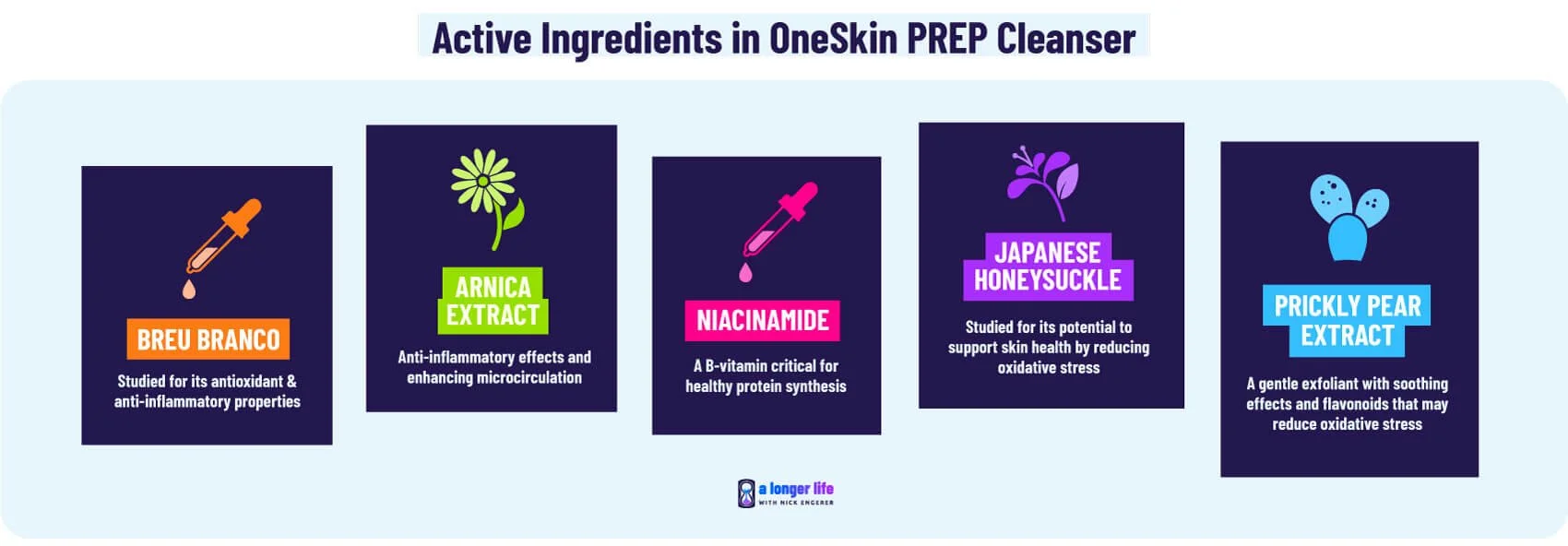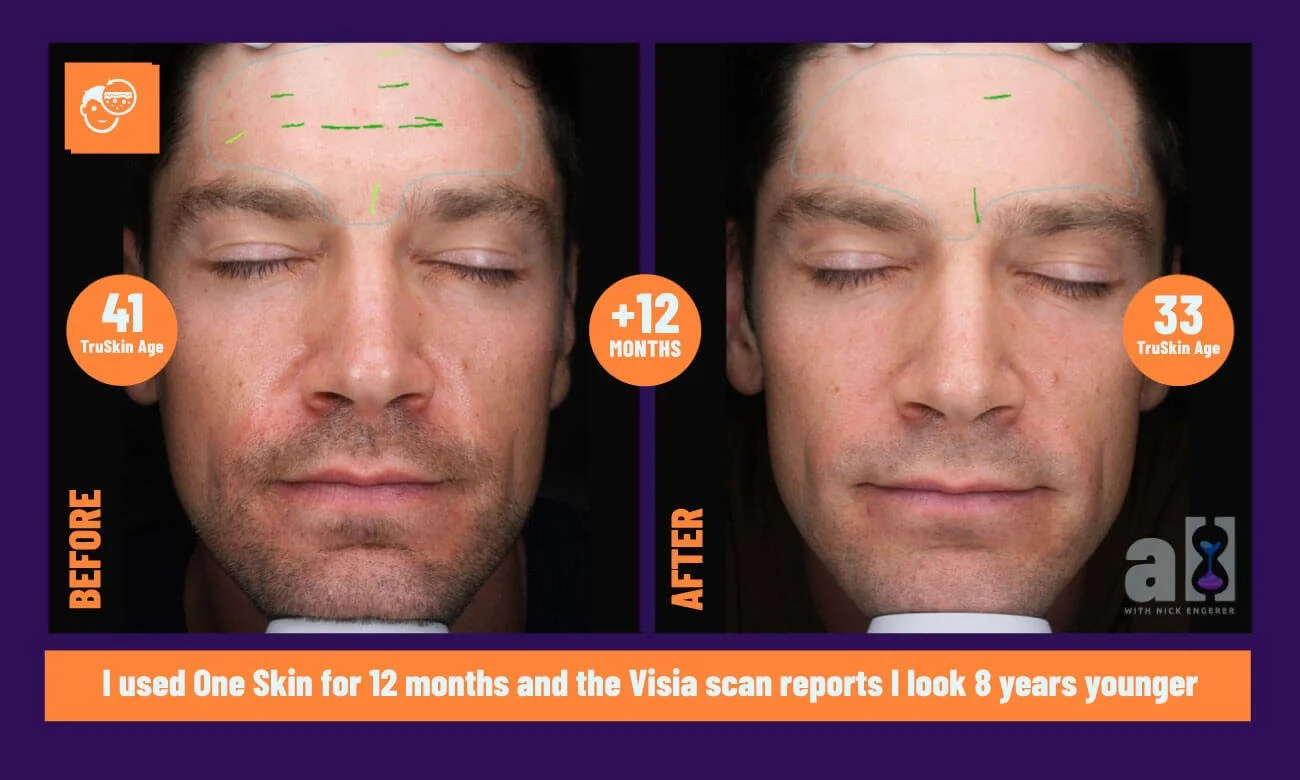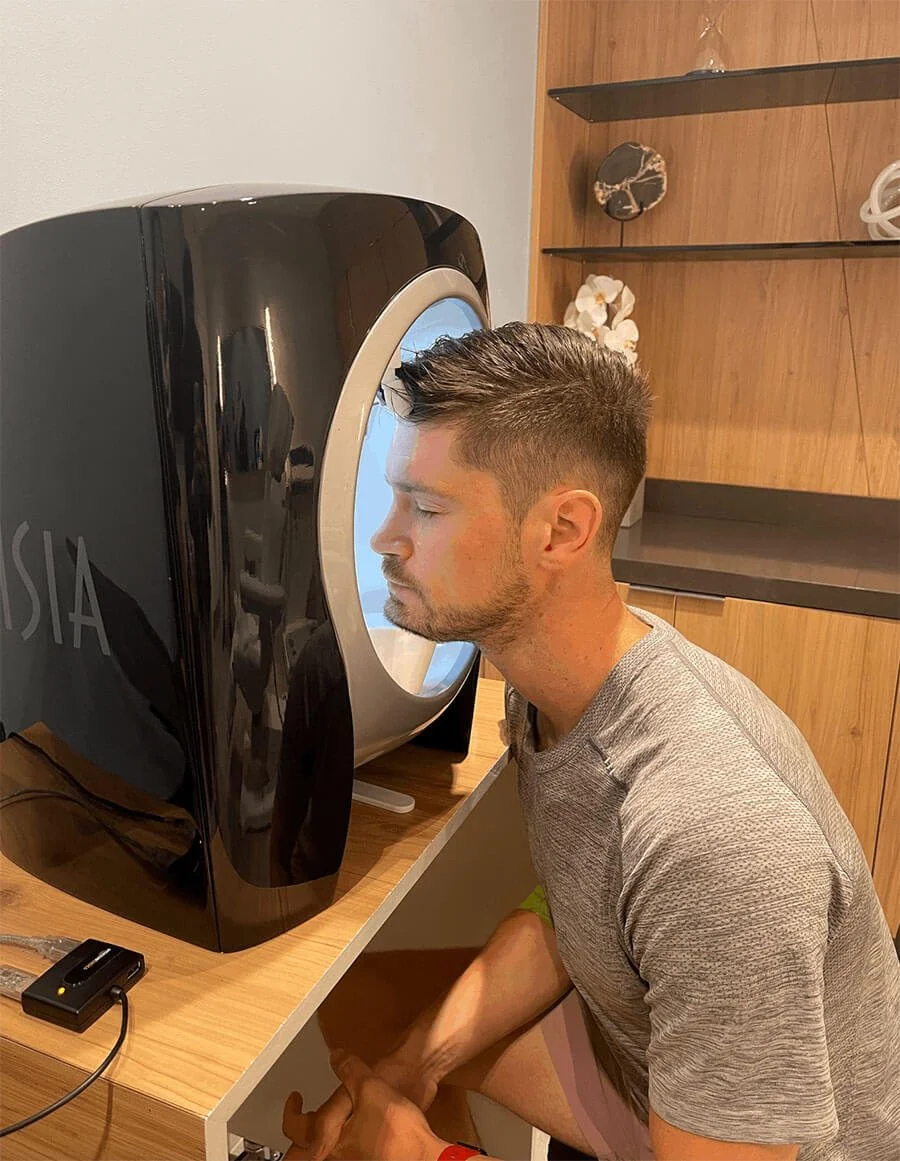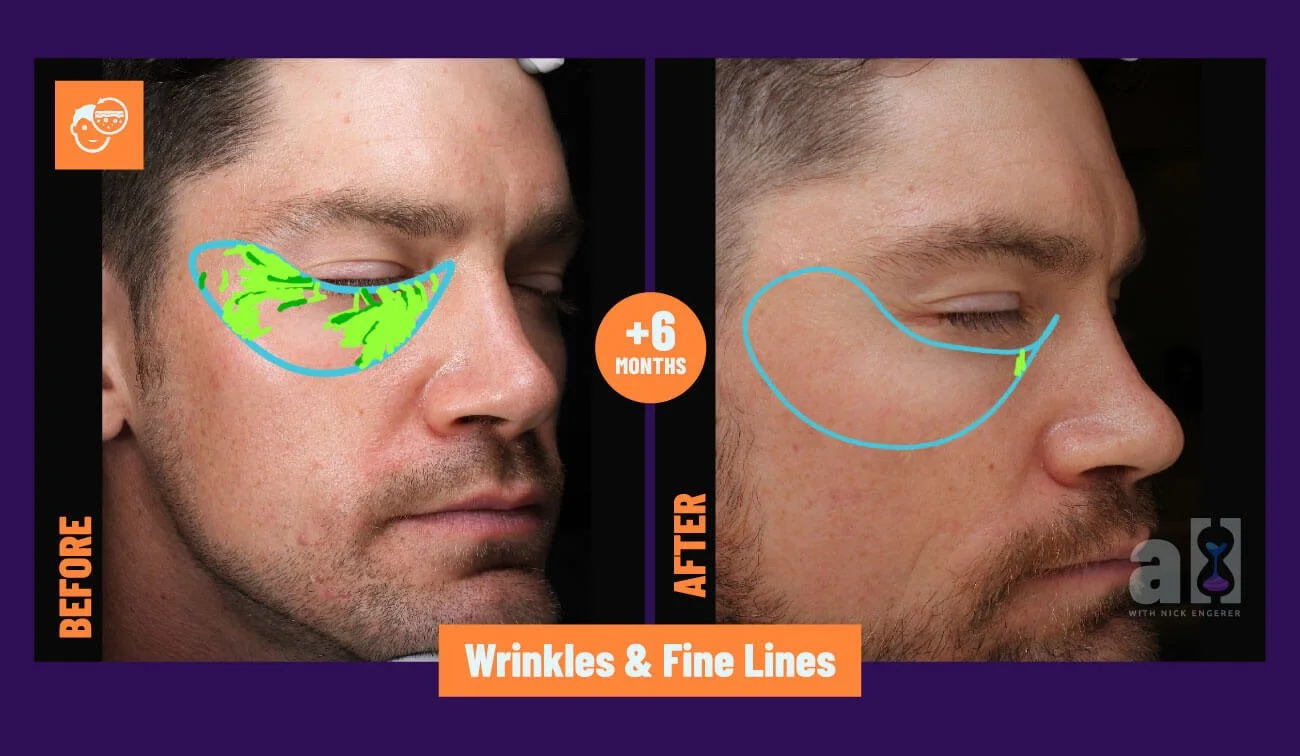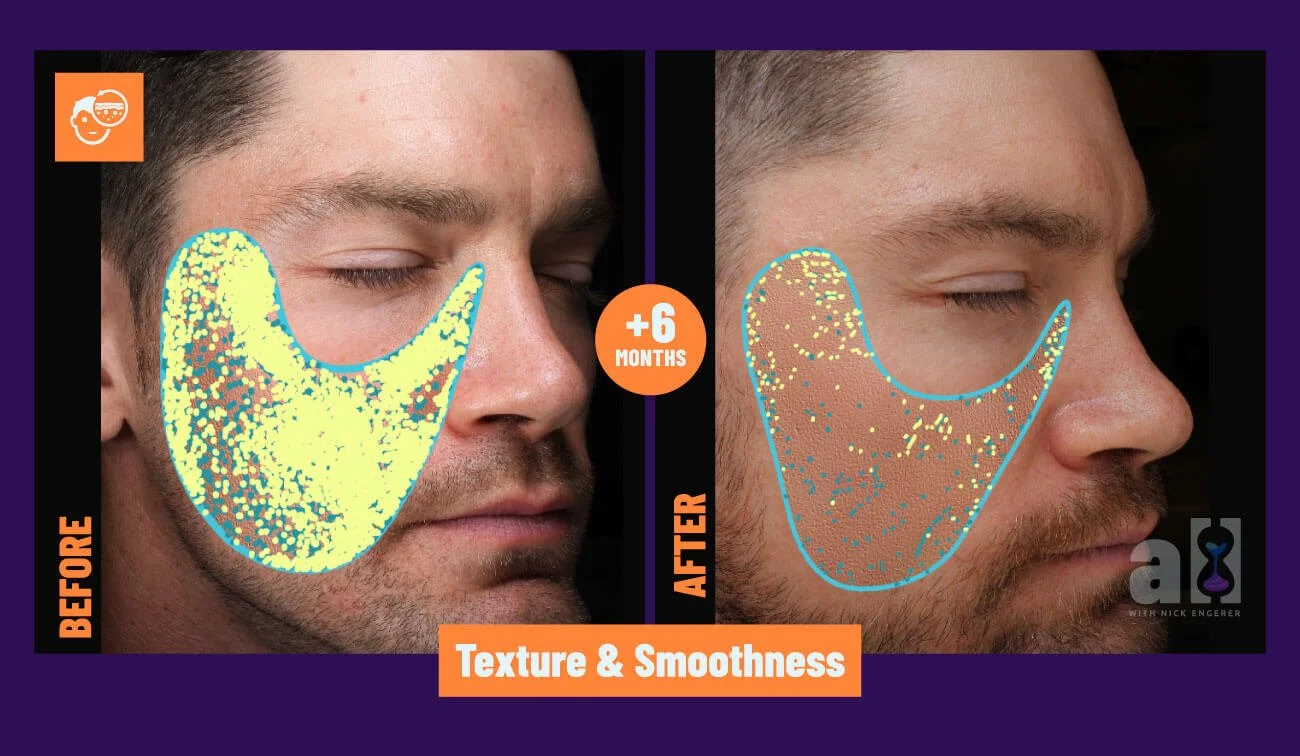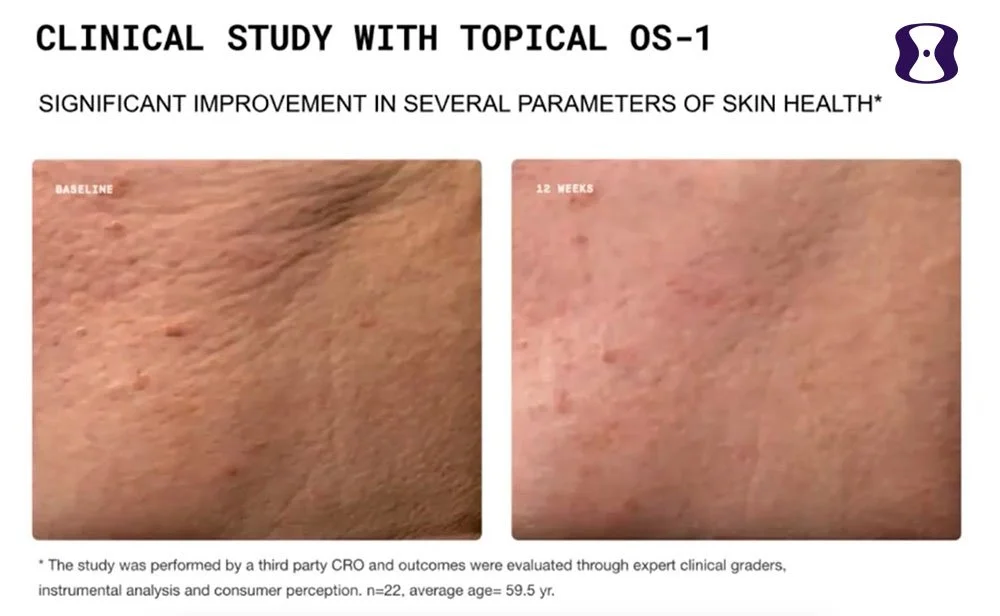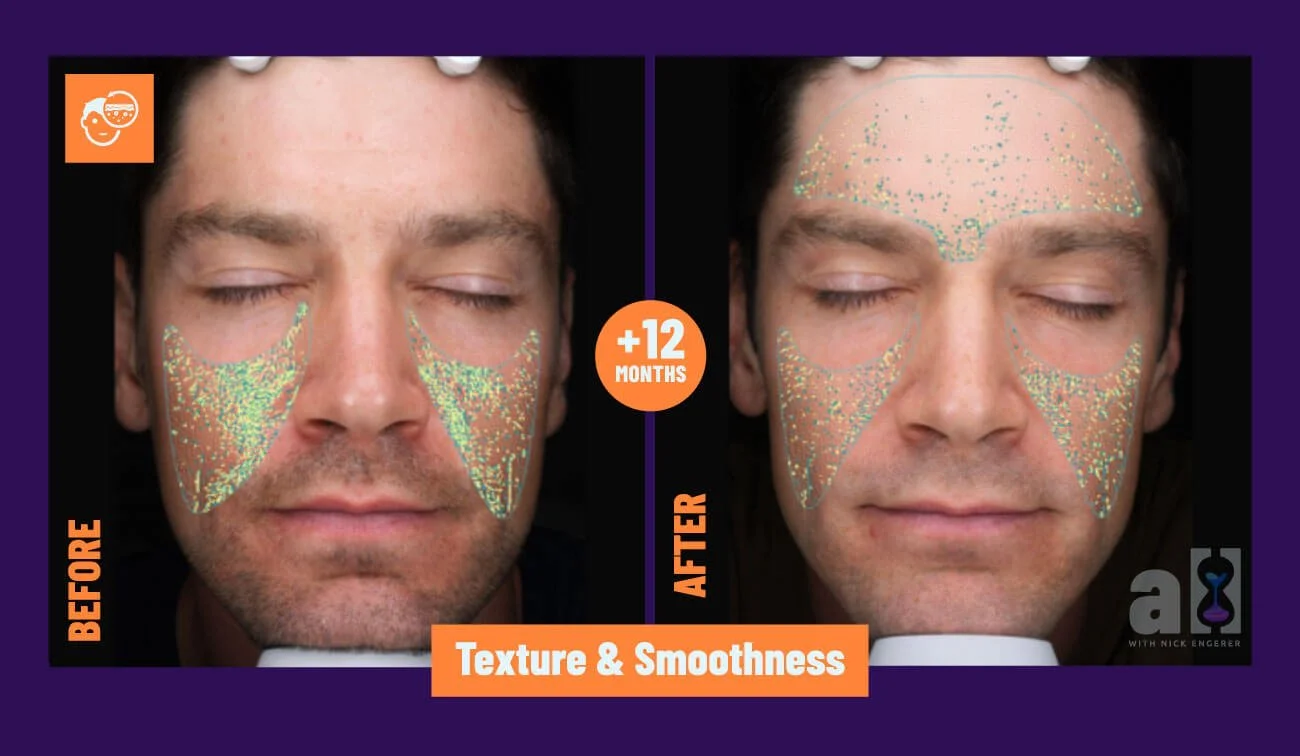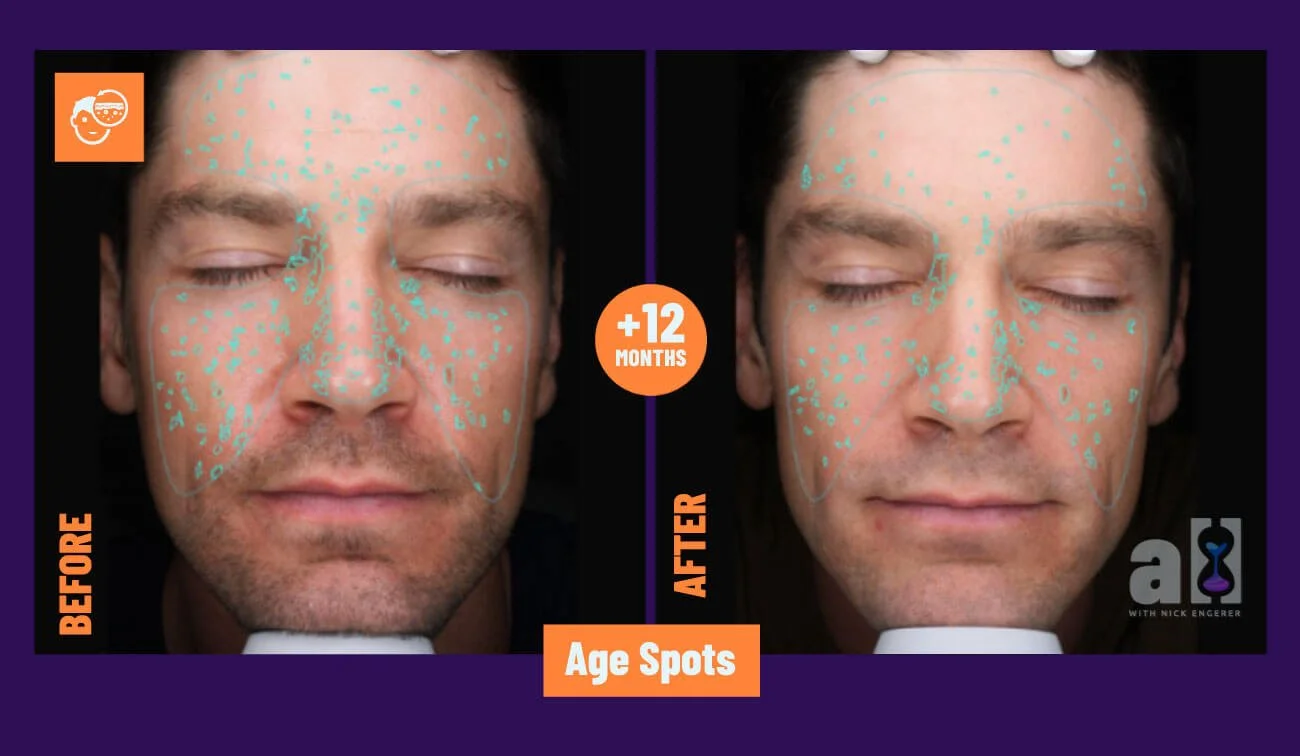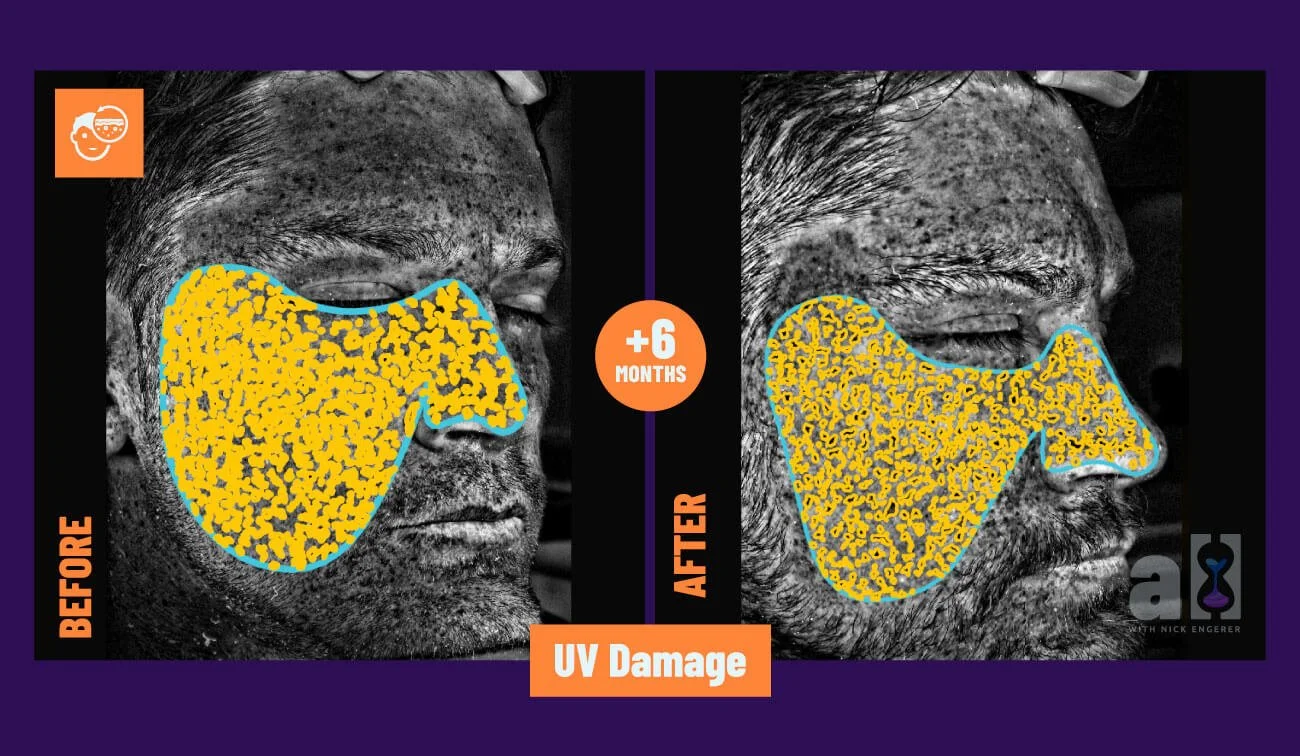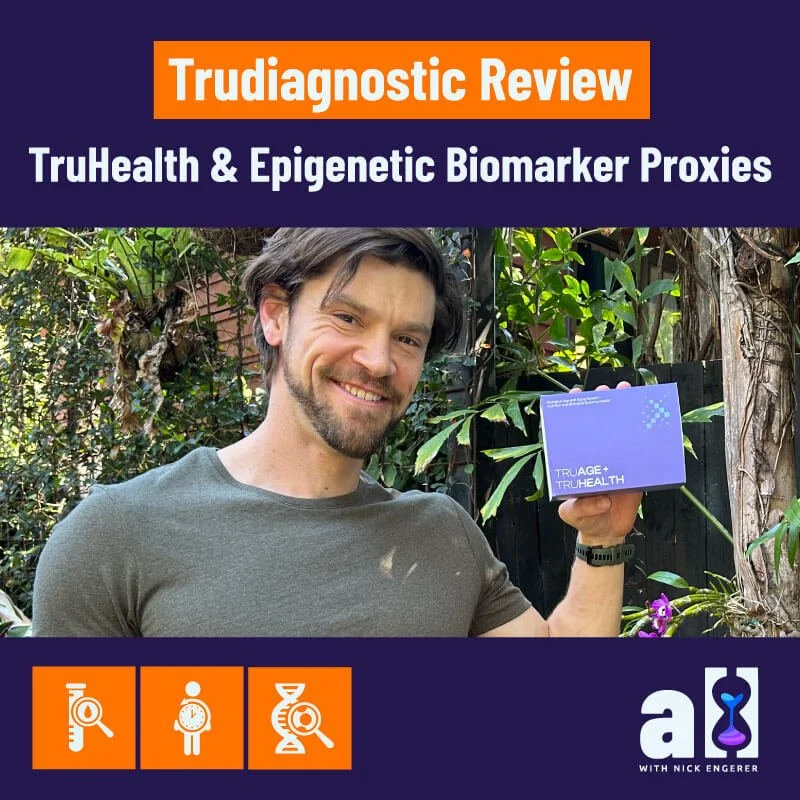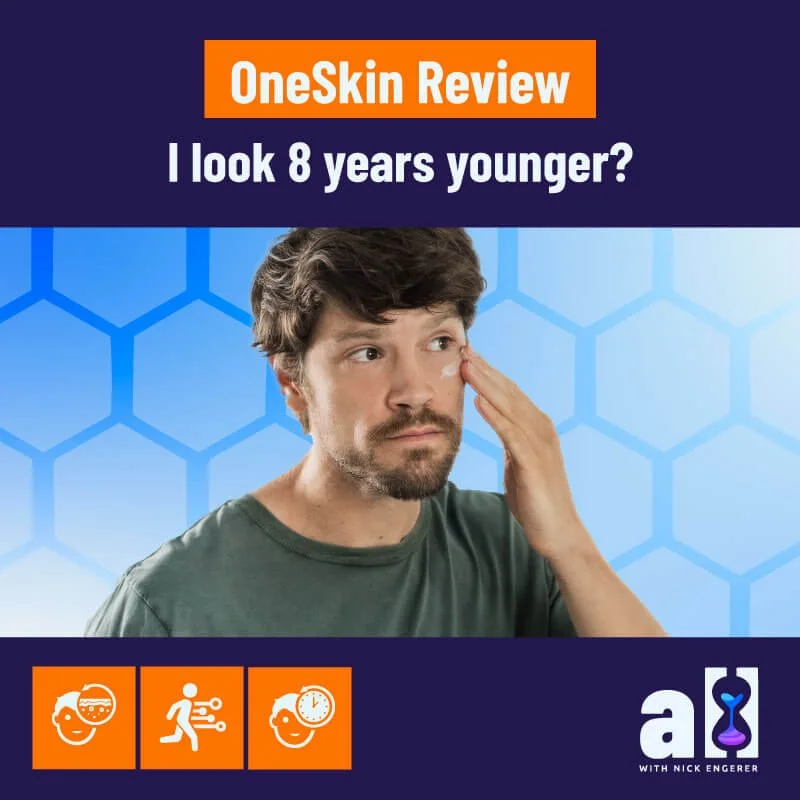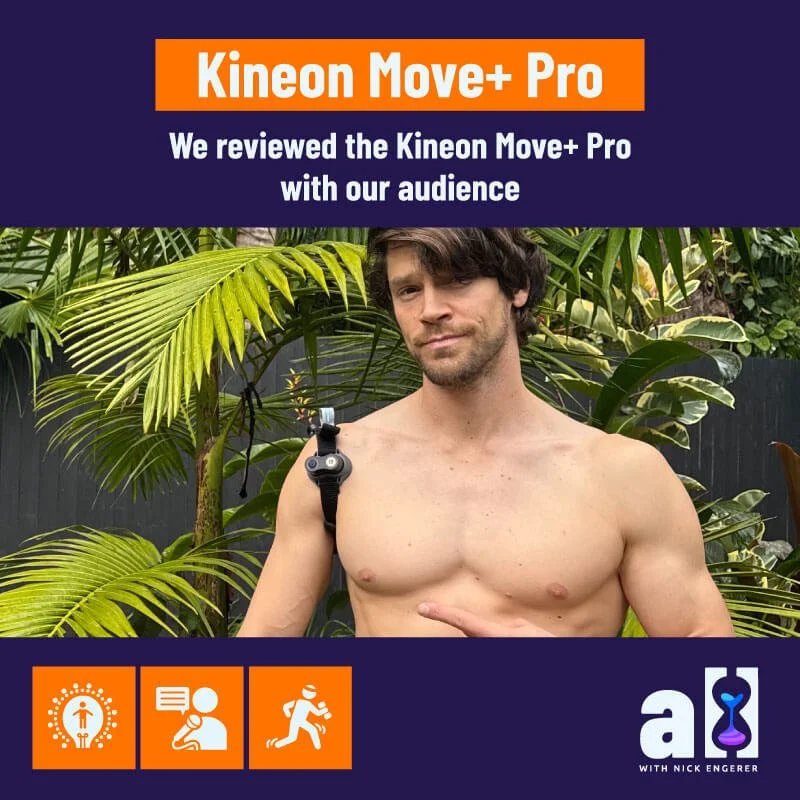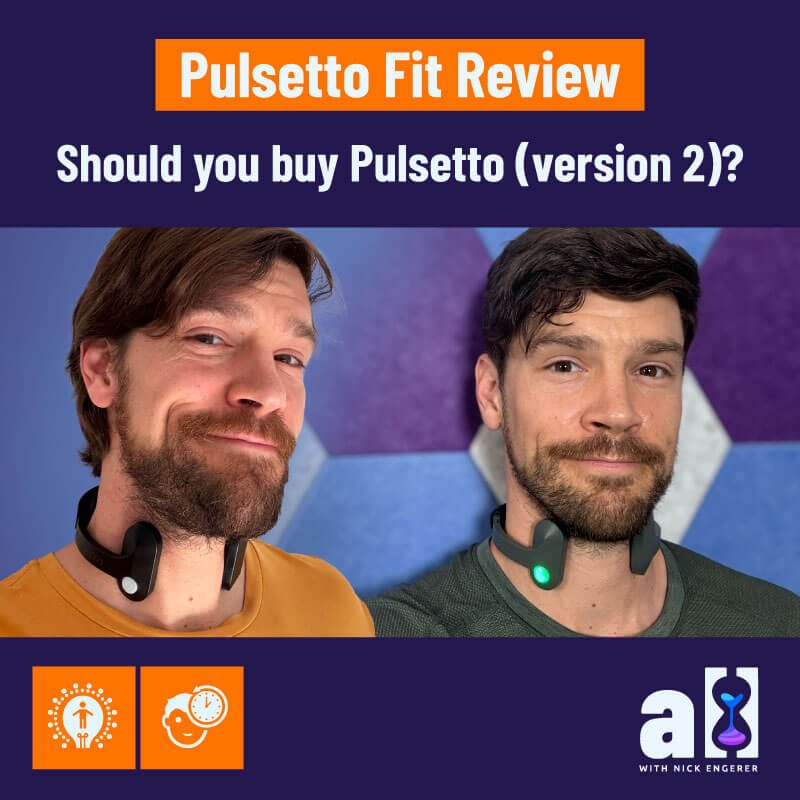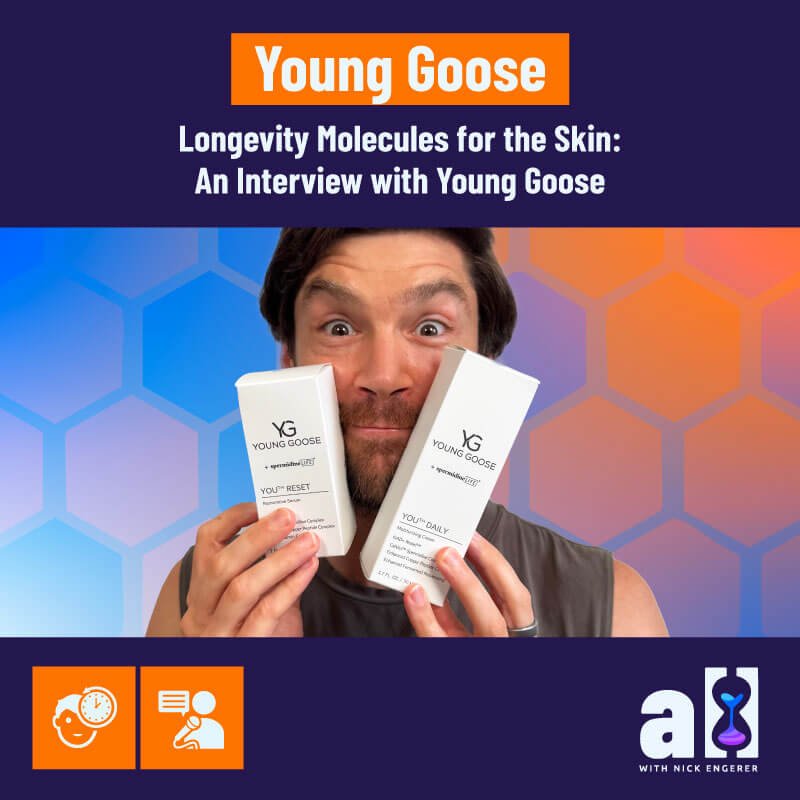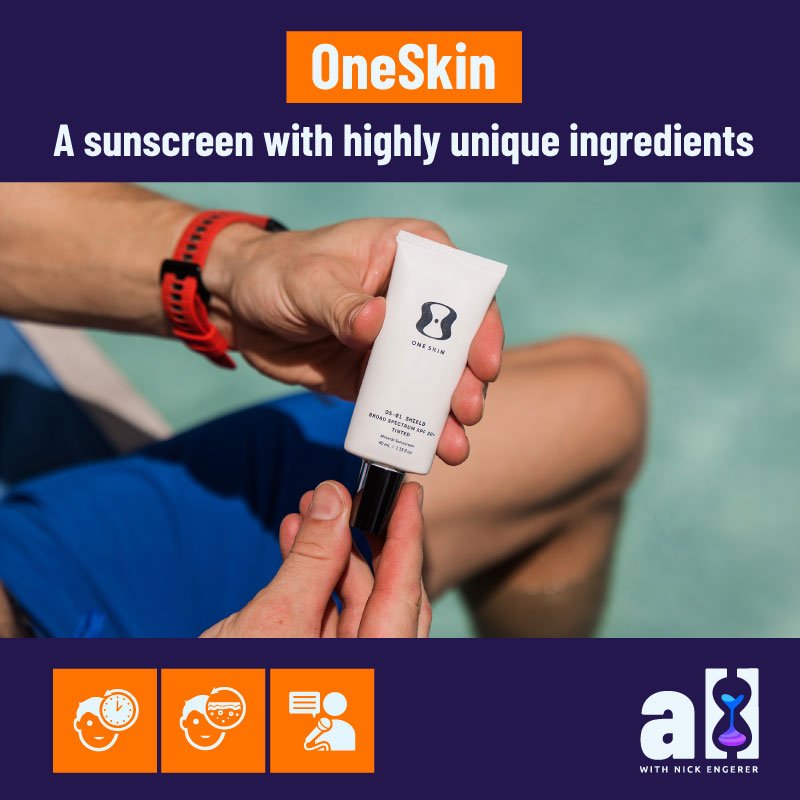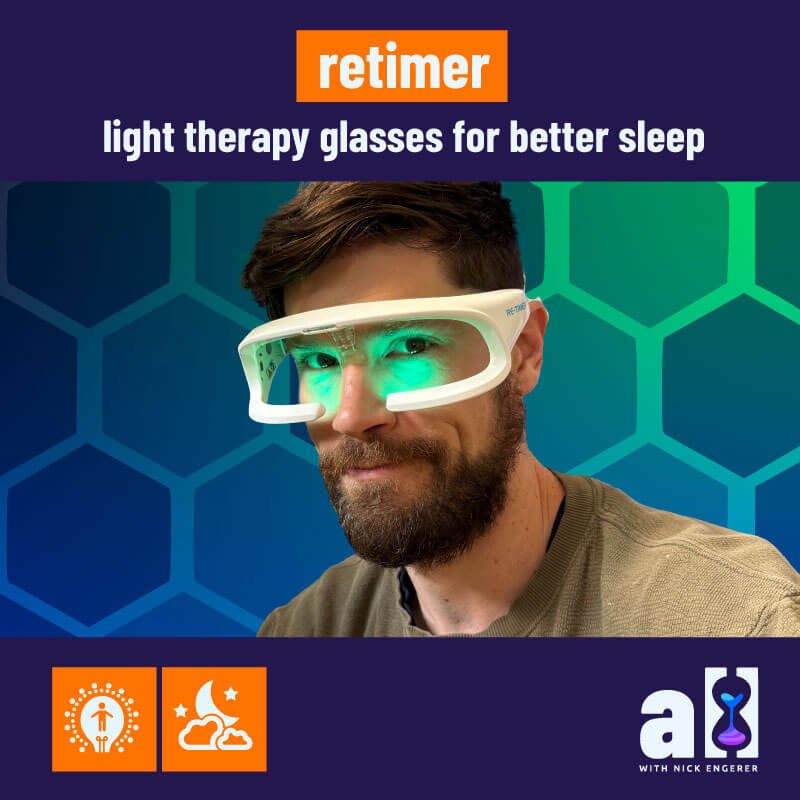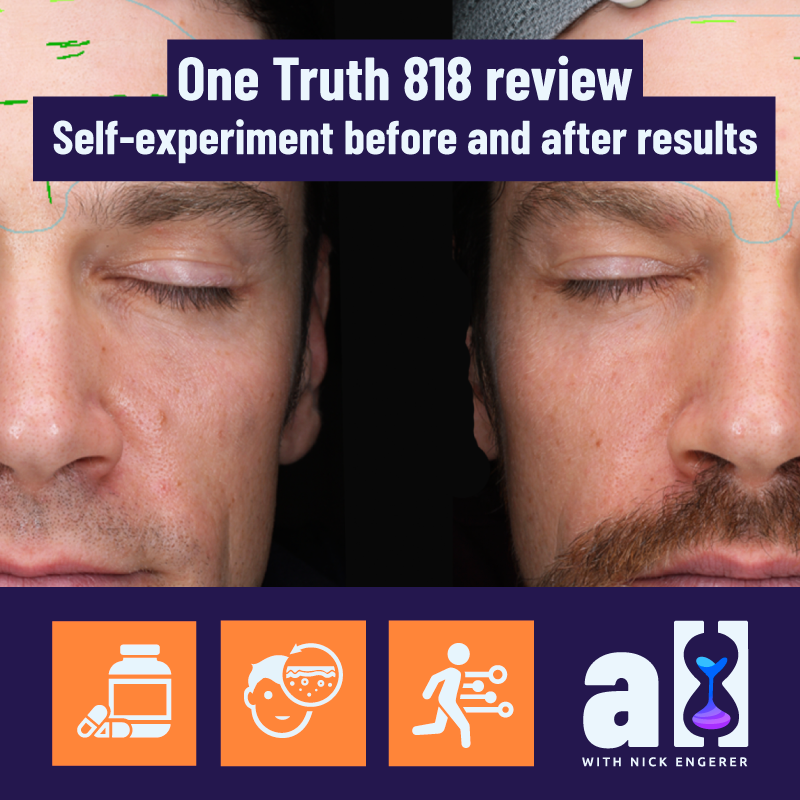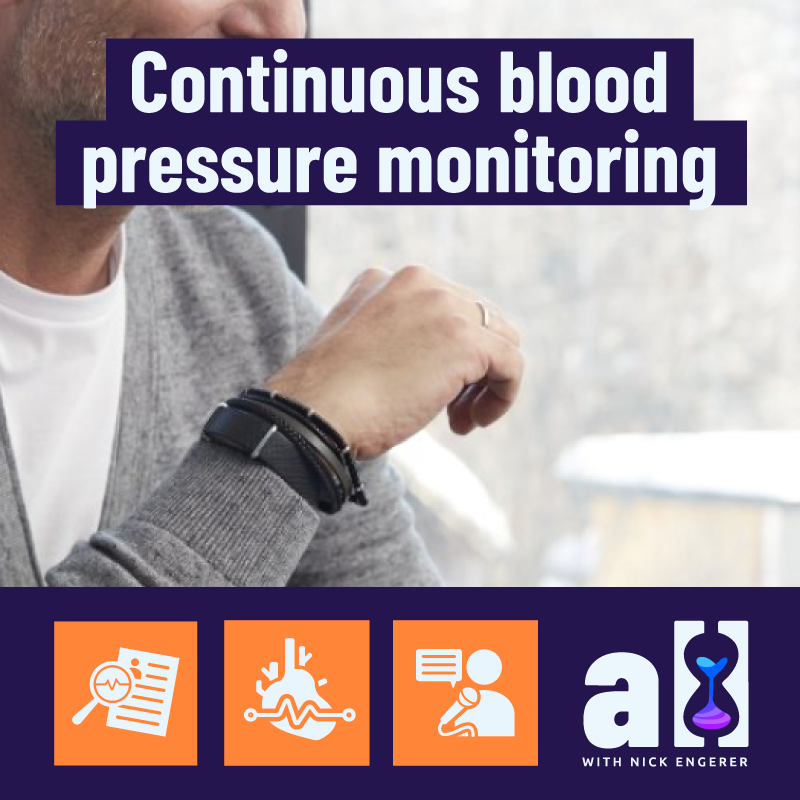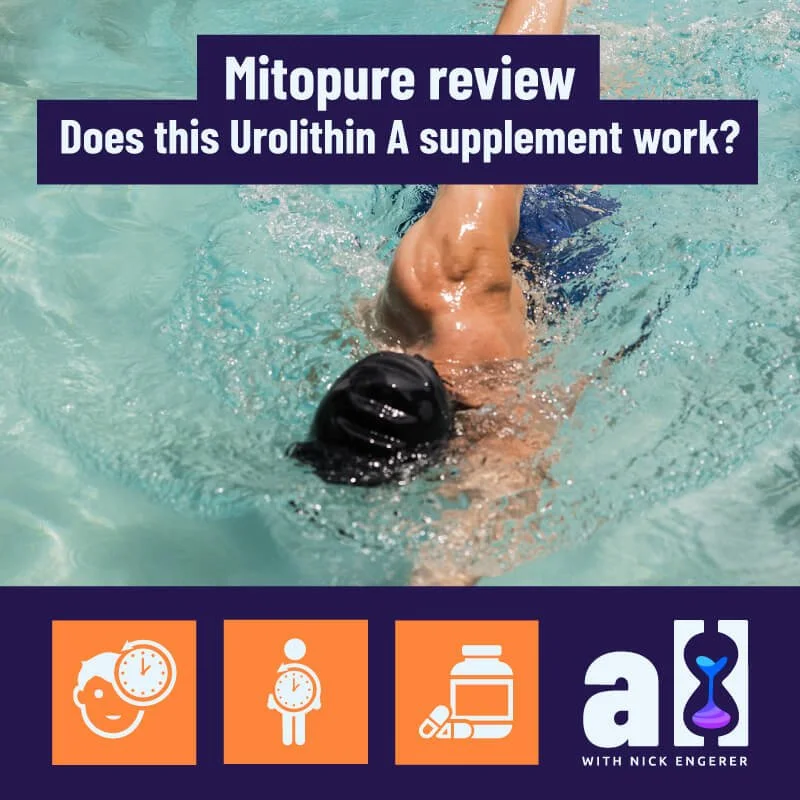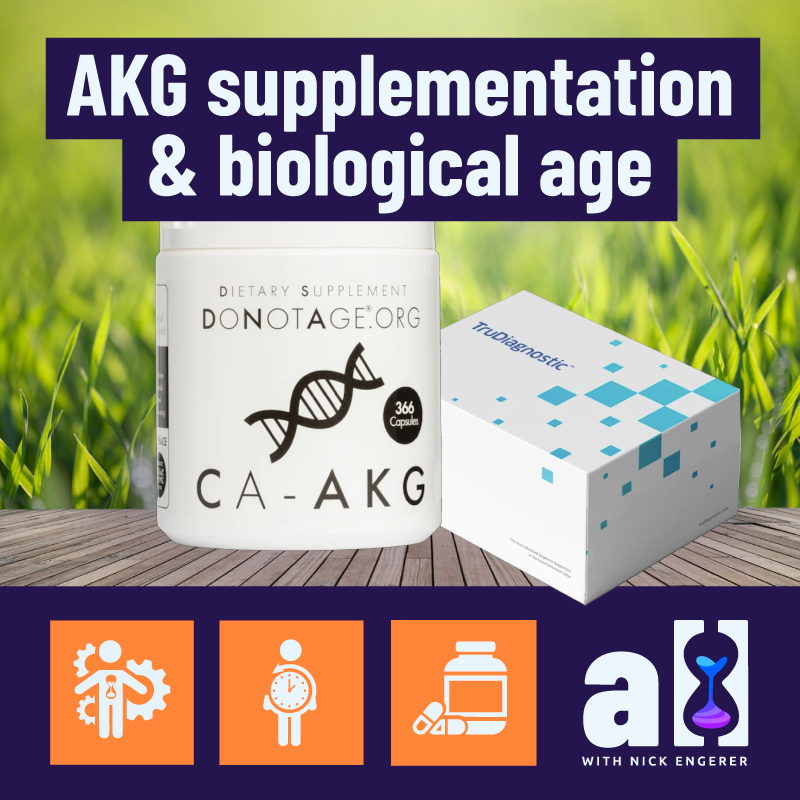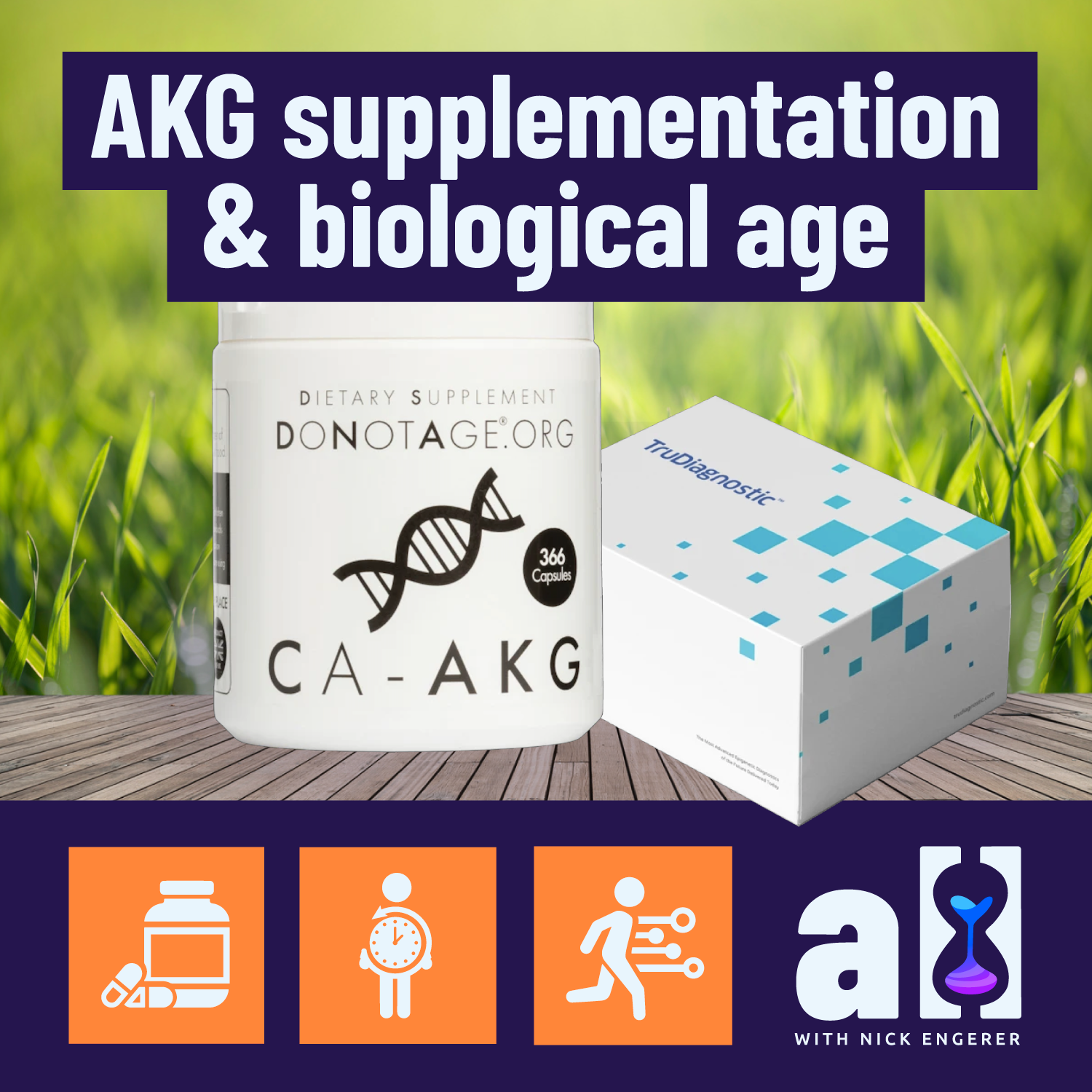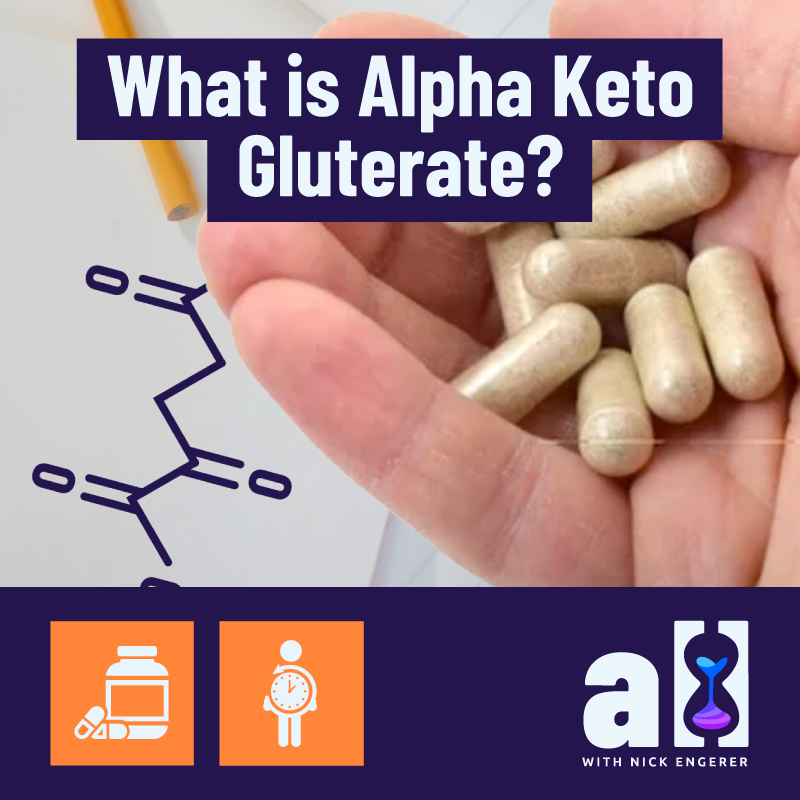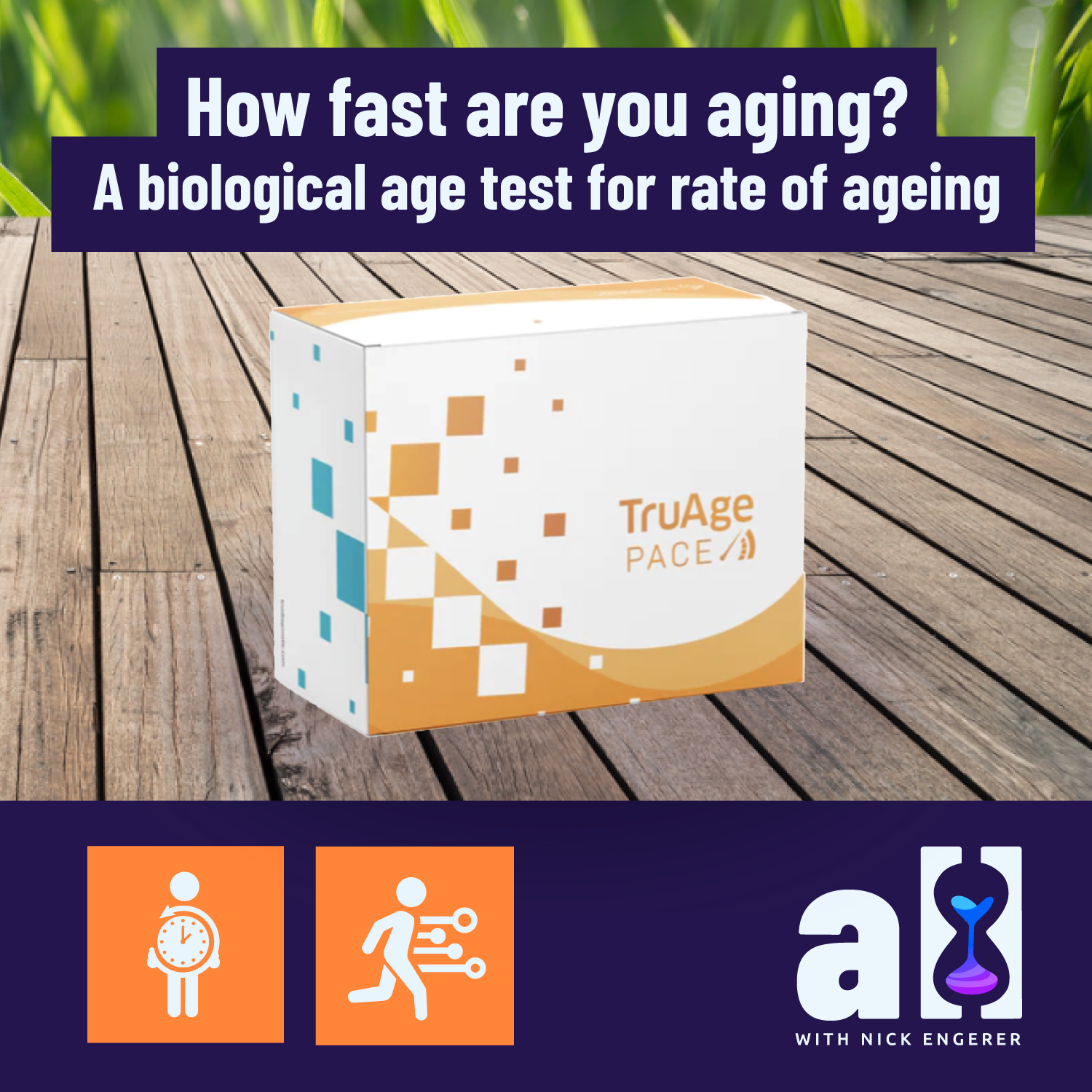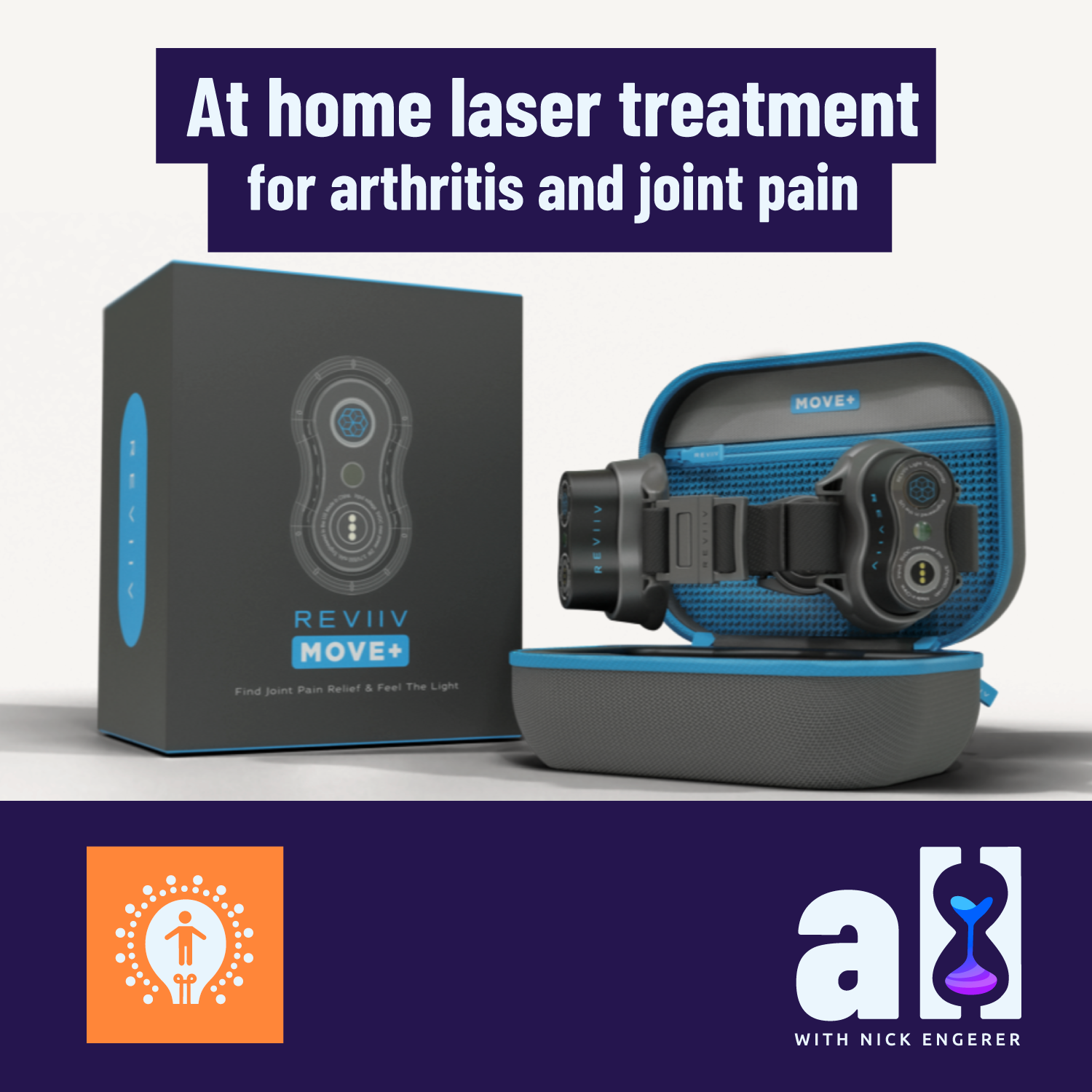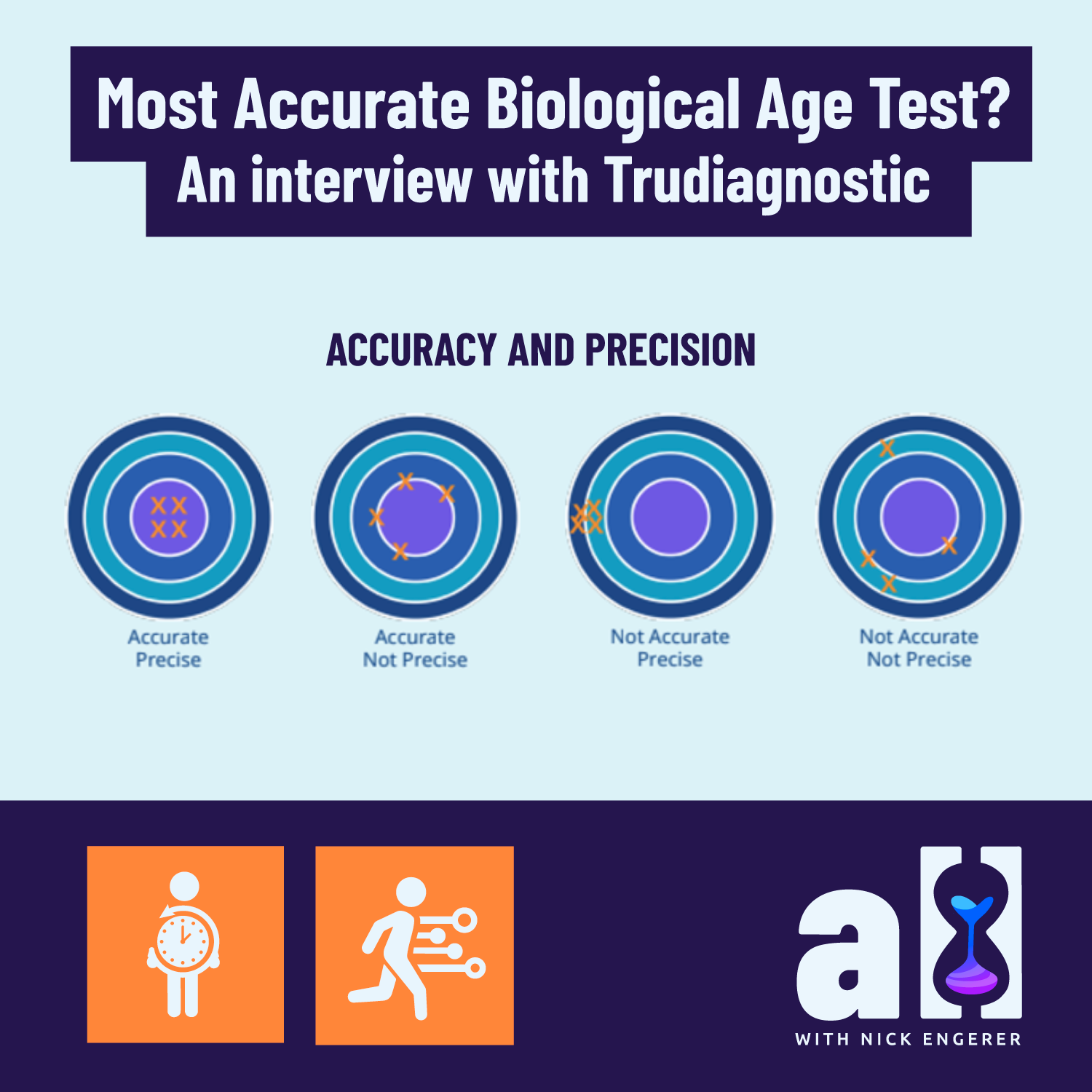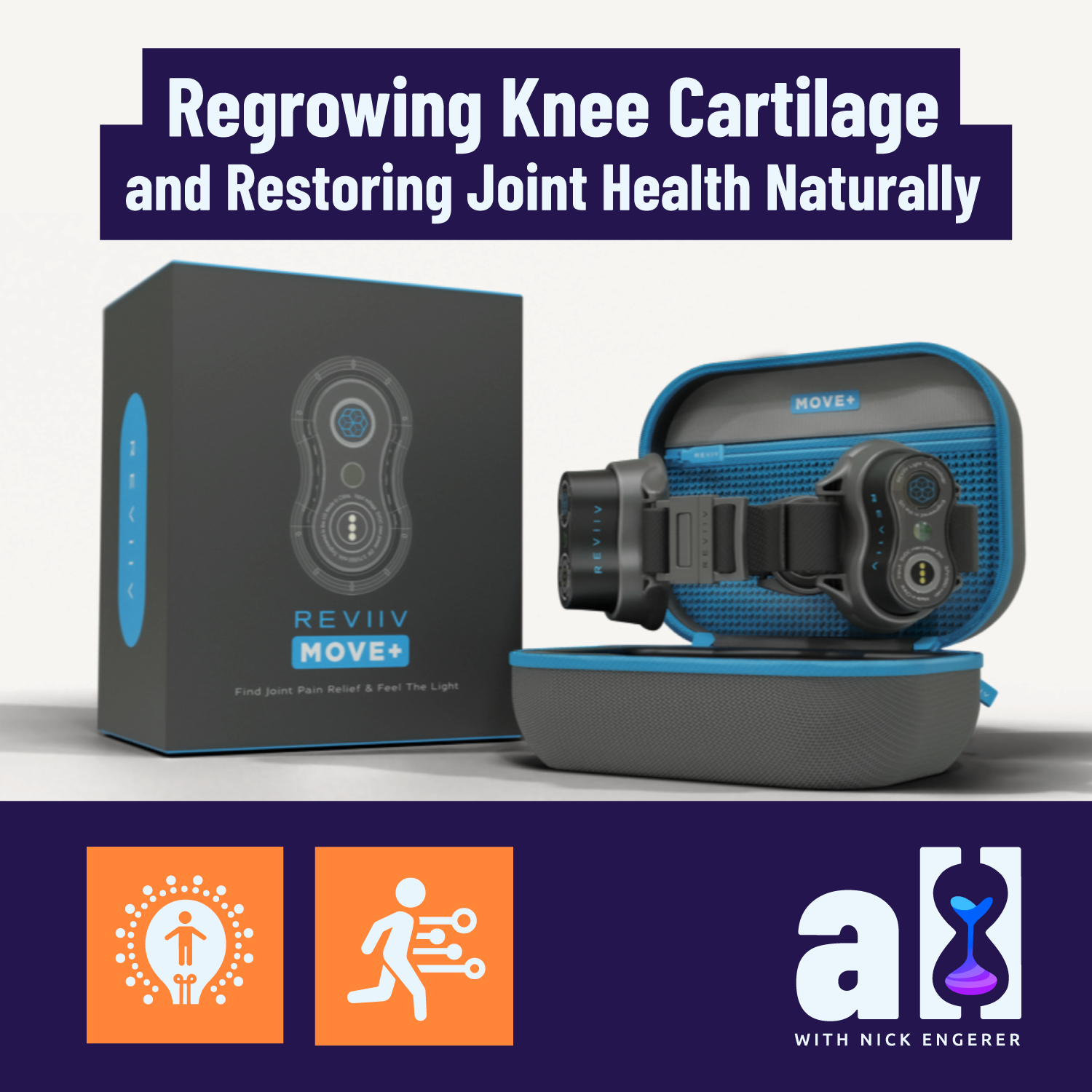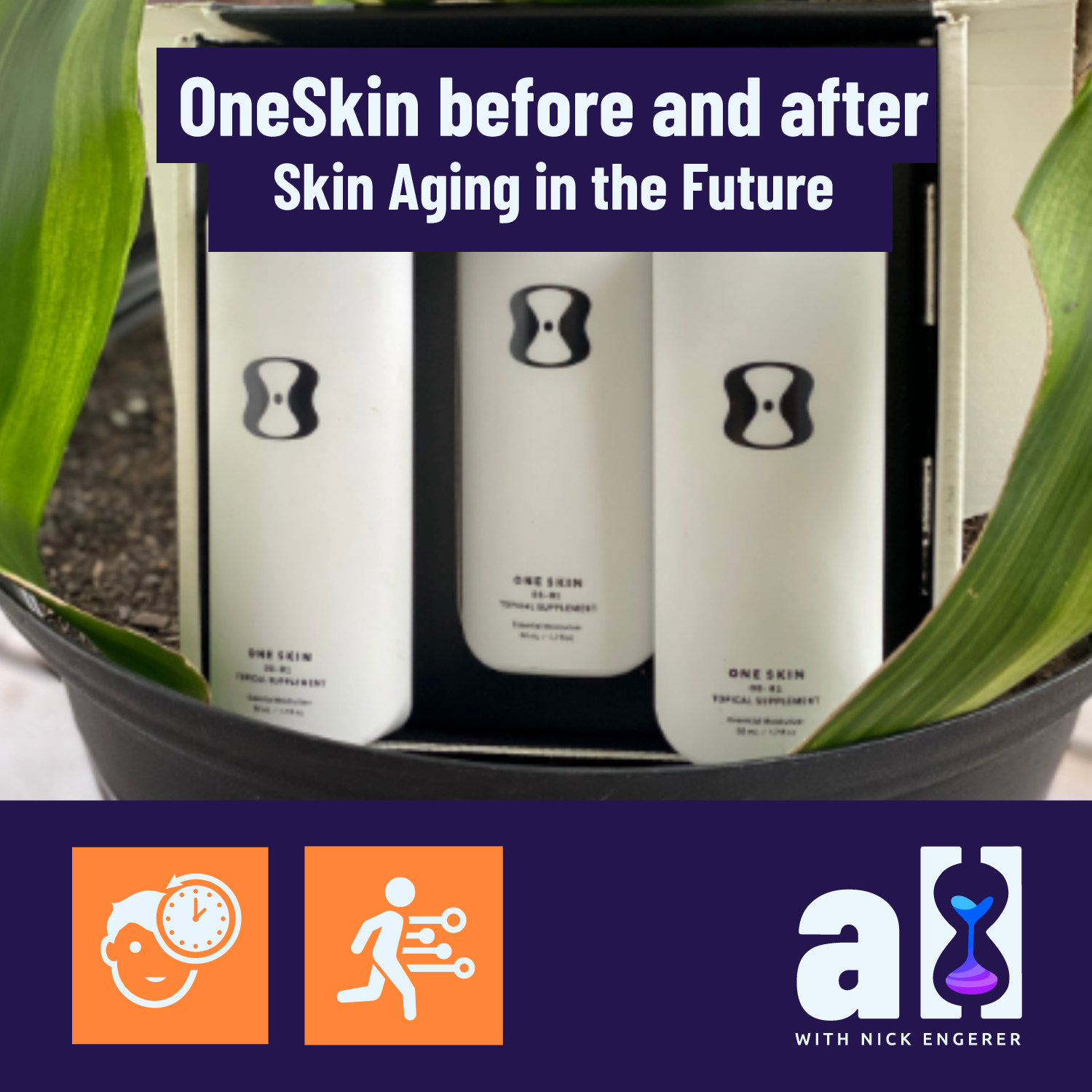Our Comprehensive One Skin Review with Before and After Results (OS-01 Peptide)
Our One Skin Review:
The OS-01 peptide line-up (Updated for 2025)
In this One Skin review, we explore the innovative skincare line-up from OneSkin, a longevity-focused company leveraging the OS-01 peptide to target skin aging at the cellular level.
Unlike traditional skincare that masks aging signs, their novel peptide OS-01, discovered through rigorous lab testing, supports cellular repair and reduces senescent cells, potentially enhancing skin health and resilience.
This article examines OneSkin’s core products—OS-01 Face, Body, Eye Cream, SPF, and PREP Cleanser—along with their key ingredients, screening them for safety, and shares objective before-and-after results from my personal 6 and 12 month trial using high-resolution Visia scanning (and how One Skin OS-01 FACE helped me look several years younger!)
While this review will focus mostly at the product level, you can take a deeper dive into the science behind OneSkin in our interviews with CEO Dr. Carolina Reis and CSO Dr. Alessandra Zonari, which offer further insights into how OneSkin aims to extend your “skinspan” (the healthspan of your skin!).
OneSkin Review Overview
First, we are not going to bury the headline. One Skin’s OS-01 FACE made me look the better part of a decade younger - and I present professional grade facial scan images to prove it.
Here’s what you can expect from this One Skin review article:
The basic science behind OneSkin and their novel peptide OS-01 (which you cannot get in any other skincare product)
An introduction to OneSkin’s core product line-up, which we have limited to their skincare products only (for the OS-01 hair product, read here)
A discussion of the formulations, active ingredients in the OneSkin products and screening the inactive ingredients for any nasties
My personal results after 6 and 12 months of trialling OneSkin skin products (which were very impressive)
If you’re short on time, we suggest you focus on reviewing the One Skin before and after results. I utilized high resolution facial imaging through a Visia scanner after adding the OS-01 FACE product to my skincare routine - while changing *nothing* else. Checking in at 6 and 12 months.
If you’re just here for the proof and the wow factor, you can skin ahead to the results section (prepare to be impressed!).
Nick with the OneSkin team during his 2024 visit
One Skin Review: The (Impressive) Science Behind the OS-01 Peptide & Products
For starters - let me just first say that I absolutely love that OneSkin positions itself as a longevity technology company rather than a traditional skincare brand, focused on enhancing the long term health of the skin—our largest organ—at the molecular level.
The term “OS-01” is the name of the proprietary peptide discovered by the OneSkin research team, which has been shown to turn on cellular repair mechanisms in the skin - meaning it is actually fixing things like UV damage and repairing skin barrier function, not just covering them up.
From their state of the art laboratory in San Francisco, the One Skin team (Co-Founded by four very impressive women) are an innovation powerhouse. And you can trust I know this first-hand after my personal visit to their headquarters in July 2024.
What is a Peptide? What does OS-01 do?
Firstly - what is a peptide? A peptide is a short chain of amino acids that serves as a building block for proteins and plays a key role in various biological processes. In the case of OS-01, it plays a critical role in skin health.
It does this by activating the cellular repair mechanisms which eliminate senescent cells from the skin. Cellular senescence occurs when cells stop dividing and accumulate damage, often due to stressors like UV radiation, becoming "senescent" cells that release inflammatory signals.
In the skin, these cells contribute to aging by triggering collagen breakdown, leading to wrinkles, loss of firmness, and age spots. This "feed-forward" loop of inflammation accelerates skin aging and impairs barrier function, compromising overall skin health.
The OS-01 peptide, identified through extensive testing (screening over 1,000 candidates) on 3D human skin equivalents replicating UV-induced aging, reduces cellular senescence by as much as 50%. This results in repair to skin barrier, improved collagen production and overall function.
Nick gives a detailed review of OneSkin OS-01 at 12 months of use
What benefits does the OS-01 peptide create in the skin?
This reduction in cellular senescence means reducing wrinkles, increasing skin radiance and eliminating age spots - through improvements in skin hydration and firmness. There is also evidence that OS-01 can make your skin biologically younger. These results set it apart from conventional skincare that merely masks aging symptoms.
In my own personal trial with the OS-01 peptide, I observed all of these alleged improvements. Changes to the wrinkles around my eyes and on my forehead were particularly dramatic. Other examples of positive impacts from this peptide abound online, including these impressive results from wellness blogger Viva Sparkle - with visually compelling changes to age spots after just 3 months of use (NOTE: Viva’s website is currently down, we’ll fix this link when it comes back online!).
One Skin Review: The OS-01 Product Line-up
For this next section of our One Skin review article, we will focus on the most popular skincare products which feature the OS-01 peptide. We will introduce you to each of them, where they might fit in your skincare protocol and check in on their unique active ingredients.
You’ll likely recall from the science background above that OneSkin is uniquely positioned to test and integrate their own line-up of active ingredients due to their unique ability to experiment in house on human skin equivalents.
So the combinations of “actives” they offer are unlike others you might find online - we’ll introduce you to their expected benefits. OneSkin have carefully formulated these to complement skin health by the individual regions of the body - we think they’ve demonstrated a lot of thoughtfulness in this effort.
We know that many of you are quite interested in avoiding any toxic ingredients or other potential hormone disruptors, etc. So we have taken a closer look at the ingredients in each product, screening them in a bit more detail by category. For each product, we used the Grok AI tool on “Deep Search” (this is a Chat GPT style tool, but goes deeply into research databases) to screen these ingredients for any known hormone disruptors or toxic ingredients - and we will share the summary response for each.
The five skincare products from One Skin that we are reviewing here are:
1. OS-01 Face: Enhancing Skin Health at the Cellular Level
OS-01 Face is OneSkin’s first and primary topical supplement. It is designed for use on the face and features seven (7) active ingredients. It is a lightweight moisturizer in a 50 ml refillable pump bottle.
2. OS-01 Eye Cream: Addressing Delicate Eye Area Concerns
OS-01 Eye Cream is tailored for the sensitive skin around the eyes, targeting issues like fine lines, dark circles, and puffiness. It features three (3) unique active ingredients and comes as an eye cream style formulation in a 20ml refillable pump bottle.
3. OS-01 Body: Supporting Skin Resilience Across the Body
Formulated for body use, OS-01 Body focuses on areas like the neck, décolleté, and hands. It contains five (5) active ingredients in addition to the OS-01 peptide. It is a moisturizer designed for larger surface areas, packaged in a 250ml ‘lotion style’ pump bottle.
4. OS-01 FACE SPF 30+ and OS-01 Body SPF: Protecting and Repairing Skin
OneSkin’s OS-01 FACE SPF 30+ and OS-01 Body SPF are formulated to shield skin from UV damage while supporting cellular health. Both include the OS-01 peptide along with five (5) active ingredients. The sunscreens are broad-spectrum mineral filters (zinc oxide and titanium dioxide) and come in a 40 ml (FACE) and 100 ml (Body) squeeze bottle.
5. OS-01 PREP Cleanser: Optimizing Skin for OS-01 Absorption
Lastly, we have the OS-01 PREP Cleanser, which aims to improve OS-01 peptide absorption. This product is a lightweight gel designed to gently cleanse and exfoliate the skin without disrupting moisture balance. It also includes five (5) active ingredients. It comes in a clear, refillable 200ml pump bottle.
One Skin Product Review:
OS-01 FACE
OS-01 FACE as its name clearly suggests is designed for use on the face. The 50 ml pump bottle is refillable, which saves you a bit on costs when it comes time to re-order (plus, we suggest you consider a subscription for further savings + use our 15% off discount code!).
The moisturizer formulation is fragrance free and is quite lightweight. In our experience, it follows well after applying your favourite serum (I personally use Young Goose YouTH Reset), as it is quite gentle on sensitive skin (which I have). I experienced no adverse reactions to the product. For the benefits of use - see our ‘Before and After’ results section below.
One of the primary benefits of the OS-01 peptide is improving the quality of the skin barrier (see the microscopic imaging shared here), which when complimented with the moisturizing effect of this product means your facial skin stays hydrated for longer.
In their 2024 study, (Double-blind, vehicle-controlled clinical investigation of peptide OS-01 for skin rejuvenation. J Cosmet Dermatol), results in 22 participants after 12 weeks of use twice daily were quite impressive.
In OS-01 FACE, there are six (6) active ingredients in addition to the OS-01 peptide. These are:
PRACAXI OIL is extracted from a South African seed, which rich in fatty acids that are documented to be moisturizing and offer anti-inflammatory benefits
ANDIROBA OIL another type of seed oil with early evidence of promoting healthy collagen and blunting the adverse effects of inflammation
NIACINAMIDE which is a B-vitamin with longstanding and well documented benefits in skincare due to its role in protein synthesis
OLEIC PAU MULATO EXTRACT which is a traditional Amazonian herbal medicine with powerful antioxidant capacity (think of it filling a role similar to Vitamin C)
ALLANTOIN to compliment the moisturizing effects of the product (its primary documented benefit)
HYALURONIC ACID delivered as three different molecular sizes to optimize absorption and function to target collagen, elastin and moisture retention.
OS-01 FACE Ingredient Safety Check
In addition to these active ingredients, OS-01 FACE contains several inactive ingredients, such as thickeners and preservatives, listed on the product’s webpage. One of these has drawn some attention - phenoxyethanol, which is an antimicrobial preservative and can act as an endocrine disruptor at high doses.
However, research indicates that the amount used in OneSkin’s formula is approximately 200 times lower than levels associated with systemic effects (citing the SCCS, European Scientific Committee on Consumer Safety). Europe is known for being fairly stringent on cosmetic ingredient regulation, so I personally find this enough reassurance.
Our DeepSearch on Grok further reinforced this position:
“The ingredients in this skincare product, including sorbitan olivate, cetearyl olivate, squalane, and others, are generally considered safe based on SCCS, CIR (Cosmetic Ingredient Review), FDA, and EWG (Environmental Working Group) assessments, with no definitive evidence of hormone-disrupting or toxic effects at typical cosmetic concentrations.
Phenoxyethanol, the only ingredient flagged for potential endocrine concerns, is used at levels far below those associated with systemic effects, though sensitive skin types should patch-test. Overall, the formulation appears designed to minimize irritation and toxicity, making it suitable for most skin types, particularly sensitive skin.”
One Skin Product Review:
OS-01 EYE
OS-01 EYE has been designed for very targeted use on the delicate skin surrounding the eyes, including the eyelids. This is scientifically referred to as the ‘periorbital’ region, a term I learned when I read OneSkin’s 12 week study evaluating the OS-01 EYE product (I just love it when one of our partners backs their products with real world science!).
The formula is a ‘cream’, and in my experience requires very little of the product to thoroughly treat the entire region - I only require half a pump. I follow the One Skin application instructions by gently tapping the product into a semi-circle around each eye region (and then massaging lightly into the skin).
Conveniently, there is also a refill option (it only saves you a couple bucks, but hey why not?) - but the real savings come with a subscription order. I’d suggest you try the 60 day option, as I think the bottle lasts much longer than 30 days. Don’t forget our discount code “longevityblog” to save a further 15% (10% for repeat orders).
Looking into the real-world scientific data, One Skin published a research paper in early 2025 titled “Clinical efficacy of OS-01 peptide formulation in reducing the signs of periorbital skin aging”. In 22 participants, after 12 weeks of twice daily use, the following results were documented:
In addition to the OS-01 peptide, OS-01 EYE contains three active ingredients:
Moringa Oleifera Seed Extract from Moringa tree seeds, which shields skin cells from pollutants that accelerate aging.
Fucus Vesiculosus Algae Extract which has some intriguing science demonstrating reduction in dark circles through breakdown of toxic iron build-up. One Skin also has some lab data showing it enhances skin luminosity.
Biomimetic Vegan Collagen which OneSkin claims “mimics” human collagen, and also claims to boost elastin, laminin, collagen, and fibronectin (Note: I’m a skeptic when it comes to topical collagen products, as evidence they penetrate the skin barrier is limited).
OS-01 Eye Ingredient Safety Check
In our review of the inactive ingredients, DeepSearch on Grok provided the following assessment:
“The ingredients in this skincare product, are predominantly considered safe based on CIR, FDA, SCCS, and EWG assessments, with no definitive evidence of hormone-disrupting or toxic effects at cosmetic concentrations.
Phenoxyethanol, the only ingredient flagged for potential endocrine concerns, is used at levels far below those associated with systemic effects, though sensitive skin types may benefit from patch-testing. The formulation appears crafted to minimize irritation, leveraging mild surfactants and soothing extracts, making it suitable for sensitive skin.””
So, it also seems to pass the toxic / disruptive ingredient test. No surprises here.
One Skin Product Review:
OS-01 Body
OS-01 Body has a different focus than the FACE and EYE products, instead being a general use moisturizer (think “lotion” style product) for use anywhere else on the body. Of particular value are the areas like the neck, upper chest (aka décolleté!), shoulders and hands. These areas often get a lot of sun exposure (UV damage) and show signs of aging earlier as a result.
The formulation is designed for a different approach given the generally thicker skin in these regions, as well as the importance of helping these regions of skin maintain a healthy microbiome. It is more heavily hydrating, for regions of the body known to be vulnerable to dehydration - namely elbows, knees and feet!
It comes packaged in a 250ml ‘lotion style’ pump bottle, without a refill option. The usage rate completely depends on how often you apply it. I tend to use the day after I’ve seen more sun exposure than usual (ad hoc use) and once per week after a dry skin brush over most of my body. A bottle at this level of usage generally lasts me 2-3 months.
Fascinatingly, use of OS-01 Body has recently been linked to lowering the biological age of test subjects, mainly through systemic reductions in body-wide inflammation. I find this particularly fascinating!
This was documented in a 12 week study of 60 females aged 60 - 90 who applied OS-01 Body twice daily (read it here). In addition to the biological age improvements, 70% of participants reported positive improvements in skin appearance. In addition to this study, OneSkin also have data supporting a 40% improvement in epidermal thickness (source).
What does this mean for you? Think less of that dreaded “crepiness” by solving this problem at its source (by fixing the skin barrier issues driving dehydration). Some of the before and after photos on the One Skin website are pretty impressive.
How do I use OS-01 Body? I do a thorough dry skin brushing to remove the top layers of accumulated dead skin cells before applying to my neck, shoulders, arms, chest and abdomen. I also make sure to get the tops of my feet because I love to wear sandals and go barefoot in the sun! You can watch the embedded video from my instagram for an example (and be sure to give me a follow for all things skin longevity focused!).
Moving into our review of the five (5) active ingredients (in addition to the OS-01 peptide!):
TREMELLA FUCIFORMIS SPOROCARP MUSHROOM EXTRACT is an antioxidant-rich ingredient studied for its potential to reduce water and collagen loss caused by UV exposure. Including it supports skin hydration and structure based on OneSkin’s own research.
CERAMIDES are a well known ingredient in skincare which contribute to the skin’s natural lipid barrier, aiding in moisture retention and repair of dry or sensitive skin.
SULFORAPHANE here derived from Lepidium Sativum Sprout Extract, offers antioxidant properties with potential antimicrobial and anti-inflammatory effects - again as directly explored by OneSkin’s scientific team.
SACCHARIDE ISOMERATE is a lesser known active ingredient, which is focused on the skin microbiome. It is a prebiotic which promotes the growth of healthy skin bacteria, potentially enhancing the skin’s natural balance.
GENISTEIN a plant-derived antioxidant with anti-inflammatory properties, genistein is studied for its ability to help reduce signs of photoaging and dark spots (based on OneSkin’s early stage cellular-focused evaluations).
OS-01 Body Ingredient Safety Check
Once again we reviewed the inactive ingredients through Grok DeepSearch, with the following summary assessment:
“The ingredients in this skincare product are predominantly safe based on CIR, FDA, SCCS, and EWG assessments, with no definitive evidence of hormone-disrupting or toxic effects at typical cosmetic concentrations.
Phenoxyethanol and polysorbate 80 are the only ingredients with minor concerns—phenoxyethanol for potential endocrine effects at high doses (far above levels used here) and polysorbate 80 for possible irritation or contamination risks if not purified—though both are generally safe with patch-testing advised for sensitive skin.”
We note the addition of polysorbate 80 in OS-01 Body is likely as a preservative. Presumably because OS-01 Body tends to sit in the bottle much longer at higher volumes given its 250ml container size. The only risk here is minor skin irritation (which presumably would be covered under One Skin’s 60 day money back guarantee should that occur for you).
One Skin Product Review:
OS-01 FACE SPF 30+ and OS-01 Body SPF
As we transition into OneSkin’s sunscreen product, it is worth noting a few things about their unique position for developing and testing an SPF product. We went into this pretty thoroughly in our 1:1 interview with CSO and Co-Founder Alessandra Zonari, which was dedicated specifically to the One Skin sunscreen products.
We mentioned before that OneSkin has novel technology which utilizes 3D human skin equivalents. These in-house models are actually grown from cells of donors across various age groups (30s to 70s). What OneSkin does next is particularly fascinating for the topic of sunscreen development - they expose these sames to UV-induced damage which directly allow them to test interventions (like additional active ingredients) in a controlled environment.
Take this to mean that they developed OneSkin’s OS-01 FACE SPF 30+ and OS-01 Body SPF by directly studying and optimising their ability to prevent and repair UV-driven skin aging. The outcome is likely one of the most effective sunscreens available on the market today (we don’t make that claim lightly!)
The sunscreen features the OS-01 peptide and 100% non-nano mineral broad-spectrum UV filters (zinc oxide and titanium dioxide based). Together these provide protection against both UVA and UVB radiation (an important detail that most overlook), while being completely non-toxic.
Both products do an excellent job of quick absorption and not leaving any white sheen. The Body formulation is a bit thicker and can get on your clothes when you are first applying it (just be careful while it absorbs). Meanwhile the face sunscreen is sheer, lightweight and does not irritate my rather sensitive skin. There are 3x tint options available, and the feedback/comments on the OneSkin product page seem to indicate that most are satisfied with the available selection matching their skin types.
OS-01 FACE SPF 30+ also does not require very much product to sufficiently cover the face. OneSkin’s instructions suggest ¼ to ½ teaspoon (about 1 to 2 ml), with re-application every two hours.
OneSkin’s SPF formulations incorporate five additional active ingredients:
VITAMIN C as a stabilized form, has been thoroughly studied for its potential to support collagen and elastin production in skin exposed to UV and blue light
GREEN TEA EXTRACT which contains EGCG, a polyphenol with antioxidant properties, has been investigated in detail for its potential to protect and support skin health
ACAI EXTRACT is antioxidant-rich and research supports its ability to help mitigate damage from environmental pollutants and advanced glycation end-products (AGEs)
TARA FRUIT EXTRACT has antioxidant properties, and is studied for its potential to neutralize free radicals and reduce oxidative stress, while possibly inhibiting enzymes that degrade collagen
BISABOLOL OIL is a chamomile-derived ingredient with soothing properties, examined for its ability to support even skin tone and protect against daily environmental damage, including UV-related effects
OS-01 SPF Ingredient Safety Check
The inactive ingredients in the OneSkin SPF line-up vary by the tint and formulation. We once again used the Grok AI tool on “Deep Search” to screen these ingredients for any known hormone disruptors or toxic ingredients, and received the following summary response:
“The ingredients in OneSkin’s OS-01 FACE SPF 30+ sunscreen formulations (Untinted, Light/Medium, Medium/Deep, and Deep) are predominantly safe based on CIR, FDA, SCCS, and EWG assessments, with no definitive evidence of hormone-disrupting or toxic effects at cosmetic concentrations.
Phenoxyethanol and propylene glycol are the only ingredients with minor concerns—phenoxyethanol for potential endocrine effects at doses far exceeding those used here, and propylene glycol for possible irritation in sensitive skin—though both are generally safe with patch-testing recommended.”
One Skin Review: OS-01 PREP Cleanser
Finally we come to the OS-01 PREP Cleanser. This gel based daily cleanser is designed to exfoliate the skin without overdrying. User reviews of the product are quite encouraging and it seems to be a well tolerated and balanced cleanser formulation.
One Skin claim that OS-01 PREP gets your skin ready for absorbing the OS-01 peptide, and that it may increase absorption of the peptide by up to 2.2x. However, this is not from published scientific studies and as far as we can tell was done in skin samples from a single 54 year old donor.
In my view, this claim isn’t well supported, and I personally do not use the OS-01 PREP cleanser beyond my own basic testing as completed for this review article. I instead use a Demacuro microfibre cloth and warm water and once per week I use an enzyme peel. It is my personal opinion that it is the exfoliation and cleansing of the skin that ‘enhances peptide absorption’, and not so much OS-01 PREP.
There may be additional benefits in OS-01 PREP that warrant it gaining a position in your daily protocol, however, because as far as a cleanser goes, it performs quite well and it is formulated with five (5) additional active ingredients:
BREU BRANCO a resin-derived extract studied for its antioxidant and anti-inflammatory properties, potentially reducing free radical damage and soothing skin irritation,
ARNICA EXTRACT derived from Arnica Montana and investigated for its anti-inflammatory effects, potential to enhance microcirculation, and ability to hydrate irritated skin.
NIACINAMIDE which we have already introduced and is vitamin B3 derivative, researched for its role in supporting skin texture through protein synthesis in the epidermal layer.
JAPANESE HONEYSUCKLE an extract that has antioxidant and antibacterial properties, studied for its potential to support skin health by reducing oxidative stress.
PRICKLY PEAR EXTRACT sourced from Opuntia Ficus-Indica, this extract is examined for its gentle exfoliating and soothing effects, with flavonoids that may reduce oxidative stress and aid in UV-damaged skin recovery.
OS-01 PREP Ingredient Safety Check
And finally for the inactive ingredient AI driven Grok DeepSearch:
“The ingredients in this skincare product, likely OneSkin’s OS-01 PREP Cleanser, are generally safe based on CIR, FDA, SCCS, and EWG assessments, with no definitive evidence of hormone-disrupting or toxic effects at cosmetic concentrations.
Phenoxyethanol is the only ingredient with minor concerns for potential endocrine disruption at high doses (far exceeding levels used here), and patch-testing is advised for sensitive skin. The formulation prioritizes mild surfactants and soothing extracts, making it suitable for sensitive skin”
OneSkin Review: Before and After Results with Photos
And now for the moment you’ve all been waiting for (or perhaps you scrolled here right away!).
My before and after photos after using OneSkin OS-01 FACE. Now, just for starters, this review did not utilize the sunscreen, OS-01 PREP or EYE. In fact, I completed this before and after self-experiment before these products even hit the market. I also completed it before the OS-01 FACE active ingredients were included in the formulation.
This is all to say that I expect that my results would have been *even better* than those I present here, had I leveraged the full One Skin product line-up.
Here’s what I did, in a nutshell:
At the beginning, middle (about 6 months) and end of the 12 month experiment, I had my face imaged with a state of the art facial imager known as a Visia Scanner
I applied two pumps of OS-01 FACE twice per day, to a clean face (warm water and microfibre towel). Once in the morning and once in the evening (just prior to bed)
I did not change anything else in my skincare routine or add any other skincare products over the course of the self-experiment.
My ‘TruSkin Age’ as assessed by the Visia scanner dropped by 7 years in just 6 months, with even further improvements after 12 months use (more on this to follow!)
Nick getting his follow-up Visa scan at NextHealth LA.
One Skin Before and After Images with a Visia Scanner
Before we continue, it is necessary to first introduce you to some of the basics of the Visia scanner and analysis. I have used this technology in many similar skincare product experiments (see here for example).
This system provides repeatable quantifiable metrics (pore size, skin redness, texture, etc) and is relatively cheap to operate (often a clinic will do this for you for free as a part of a skincare consultation). It provides consistent lighting and photo angles (look carefully at other ‘reviews’ on you’ll see their photos seldom match at all!
While this TruSkin Age is a proprietary algorithm and we cannot know exactly how it works; Campbell Scientific have shared the eight most influential metrics which go into the TruSkin Age calculation.
These metrics are highly valuable for tracking the impact of skin care treatments over time.
Some of these metrics are more responsive to a given intervention than others. So it is important to know which of these metrics to pay attention to when you’re self-experimenting.
Using abridged descriptions from the Campbell Scientific FAQ page and bit of input from skincare specialists, we decided to track four metrics in this self-experiment with OneSkin OS-01:
Wrinkles: Wrinkles are furrows, folds or creases in the skin, which increase in occurrence as a result of sun exposure, and are associated with decreasing skin elasticity. This skin feature has the greatest variability from image to image as it is highly dependent upon the facial expression of the client.
Texture: Texture is primarily an analysis of skin smoothness. Texture measures skin color and smoothness by identifying gradations in color from the surrounding skin tone, as well as peaks (yellow) and valleys (blue) on the skin surface that indicate variations in the surface texture.
Spots: Spots are typically brown or red skin lesions including freckles, acne scars, hyper-pigmentation and vascular lesions. Spots are distinguishable by their distinct color and contrast from the background skin tone. Spots vary in size and generally have a circular shape.
UV Spots: UV spots occur when melanin coagulates below the skin surface as a result of sun damage. UV spots are generally invisible under normal lighting conditions.
We’ll now progress through the results from each and discuss.
One Skin Review: Before and After Wrinkles
The improvements to my wrinkles - particularly around my eyes and on my forehead were, to be blunt, unexpectedly amazing. When I set out to test OS-01 FACE, I thought I might see marginal improvements - but One Skin was a gamechanger.
“The change in the wrinkles around my eyes was my biggest visual observation,” reports Nick. “I’ve actually looked in the mirror and said ‘Wow’ out loud. I really feel as if I turned back the clock with my eye wrinkles”
Note: This was my first time performing a before and after self-experiment with the Visia scanner, you’ll notice that I did not quite get like-for-like images in the 6 month before and after scans. I’ve since learned how to do this, and the 12 month before and afters are much better side by side comparisons.
6 Month Results: Before and After - Wrinkles
Did the Visia scan agree with my personal observations at 6 months? Emphatically yes. In the before image, a significant number of individual, smaller wrinkles around the eyes were detected (noted in green).
In the after image, the periorbital skin is relatively unwrinkled. Even the fine lines were largely gone. And while there was likely an impact on the wrinkle algorithm from change in facial angle (see above note), it is very unlikely that this is the source of such dramatic improvement.
The biggest impact of the difference in before and after facial angle is the change in the looped area (blue line) closest to the nose/inner eye. However, even if we removed the entire region below the eye due to this effect, there would still be a very significant change in wrinkles along the outer eye/upper check junction.
12 Month Results: Before and After - Wrinkles
At the 12 month mark, wrinkle reversal continued steadily. This was most noticeable in the forehead region, where there were significant improvements. In fact there was a 80% improvement in the ‘wrinkle’ score on my forehead as determined by the Visia scanner - dropping from a score of 10 to just 2.
My age and gender adjusted ‘percentile’ score went from 18th percentile all the way to 65th percentile, which is a very positive change (higher is better for this metric).
One Skin Review: Before and After Skin Texture
Moving onto our next metric, we analyse skin texture.
In this metric, the overall score for texture is less significant than the total number of different blue and yellow dot pairs. These are the “peaks (yellow) and valleys (blue)” on the skin surface.
6 Month Results: Before and After - Texture and Smoothness
We observe a dramatic improvement in skin smoothness/texture after 6 months.
While there may have been impacts from the slightly different imaging angle and small variations in the facial scanning region (the blue loop around my cheek), neither could account for such a large difference.
At 6 months OS-01 FACE was already providing major improvements to my skin texture, which is very likely in direct connection with the OS-01’s improvements to my skin barrier health and function.
Improvements in skin texture and smoothness after topical application of the OS-01 peptide have also been observed in the clinical setting.
Source: OneSkin
12 Month Results: Before and After - Texture and Smoothness
The 12 month results allow us to watch this transformation continue and view it from another angle. While we did not get before and after data on the forehead (see “note” above) - the cheek up to the nose region is most certainly in play.
Based on the metrics reported by the Visia scanner, my results improved from the 46th percentile (age and gender adjust comparison data) all the way up to 95th percentile. This means that my skin became smoother than 95% of other men my age - that is simply a tremendous result!
OS-01 FACE ‘smoothed’ my face dramatically and my skin texture saw a night and day difference at both the 6 and 12 month mark.
One Skin Review: Age Spots
Age spots are one of the most notable and widely recognised signs of skin aging.
Such ‘spots’ are detected by the Visia scanner, which is searching for brown/red skin ‘lesions’ (including moles and freckles) and also hyper-pigmentation.
We know from other anecdotal sources that improvements in ‘age spots’ have been notable. You can see a great example of this in the photo from VivaSparkle (which we shared above).
6 Month Results: Before and After - Spots
My age spots before and after results with One Skin were pretty clear by the 6 month mark.
While there are slight variations in the scanning angle and the looped region of analysis (blue line), the changes in the density of detected age spots are quite clear.
There are fewer age spots per unit area on my cheek, jawline and nose. This is telling us that skin cells are healthier at the cellular level.
Based on these results, I believe it is clear that the OS-01 peptide is directly responsible for reducing the number of age spots on my face.
12 Month Results: Before and After - Spots
After one year with OneSkin, my age spot intensity and frequency dropped by a total of 40%!
In this front-on view, we observe a significant clearing in the forehead region as well as on the nose.
There are also quite a few instances of larger age spot regions shrinking over the 12 months.
One Skin Review: Before and After - UV Damage
Lastly, we review the before and after results for UV spots. These spots are picked up using a special UV imager and a flash of UV light, to make these spots visible (they are invisible to the naked eye).
They form as a result of UV damage, as the melanin coagulates beneath the skin surface, and will eventually lead to visible damage at the skin’s surface and are a sure sign that collagen is also being degraded.
As the scientific team at One Skin have repeatedly pointed out, this is one of the primary drivers of skin aging. This is why the OneSkin laboratory uses UV radiation in the lab to artificially age their 3D human skin equivalents.
Did we see any changes to existing UV damage in my skin after 6 and 12 months use?
6 Month Results: Before and After - UV Damage
At 6 months we did not observe a definitive result with UV damage. While there may have been a slight decrease in the density of UV ‘spots’ before and after, it was not conclusive.
The UV damage score provided by Visia dropped in the after image by over 20%, but this could easily have been due to the small variation in scanning area/angle.
12 Month Results: UV Damage
Again at the 12 month mark, UV damage was largely unchanged. There was a small change in overall ‘score’ (total number of instances of UV damage in the image) but no significant change to my UV damage percentile.
What this does seem to indicate however, is that UV damage was stable across this period of time. That in itself is notable - given that my skin experienced a full calendar year of aging and additional UV exposure (while being an endurance athlete in a sun soaked country - Australia!) - but no additional damage.
I believe this is demonstrating that the OS-01 peptide is “holding the line” against additional damage through the cellular repair mechanisms it switches on (but this is my personal conjecture!).
One Skin Review Conclusion - We love it!
After these fantastic results, I have continued to faithfully use OneSkin OS-01 FACE daily. I have confidently added it to my regular skincare protocol, as I am thoroughly convinced that the OS-01 peptide is helping to keep my skin younger.
Why? The evidence was simply overwhelming. It has had impressive impacts on my wrinkles, age spots, pigmentation and UV damage, which warrant its continued and ongoing use.
I also am a firm believer and an advocate that you need to do your own before and after experimentation to know if One Skin will work for you. This is precisely why we aim to support our readers with examples on how they conduct their own self-experiments to see what longevity technologies work best for them. This is core to our philosophy.
If this review helped you, be sure to subscribe to our newsletter, we are reviewing longevity focused skincare products regularly!
We’d also love to hear from you, if this review helped you make a more informed decision.
One Skin Frequently Asked Questions (FAQ)
The Top 5 OneSkin Questions - Answered!
1. What makes OneSkin different from other skincare brands?
OneSkin’s formulas are built around the OS-01 peptide, a breakthrough ingredient designed to target the root causes of skin aging at the cellular level. Unlike products that simply mask signs of aging, OneSkin supports healthier skin by reducing the build-up of aged (senescent) cells and helping your skin function more like it did when it was younger.
2. When will I start to see results?
Everyone’s skin is different, but most people notice a boost in hydration and softness within the first two weeks. After about six weeks of consistent use, you may see firmer, smoother skin with fine lines and wrinkles becoming less noticeable. The best results often come after 12 weeks or longer.
3. Is OneSkin safe for all skin types?
Yes, OneSkin products are clean, vegan, cruelty-free, and designed for all skin types. The OS-01 peptide is gentle enough for sensitive skin and can be a great option if you’ve struggled with retinol or harsher treatments. As always, we recommend patch testing any new skincare product.
4. How do I use OneSkin in my daily routine?
It’s easy! Apply OneSkin products to clean, dry skin ideally right after cleansing or bathing to lock in moisture. You can use OneSkin alongside your other favorite products. The key is consistency: daily use delivers the best results.
5. Is OneSkin worth the price?
We believe so and so do many of our customers. OneSkin stands out for its science-first approach and focus on supporting long-term skin health, not just short-term fixes. If you’re looking for skincare that helps your skin age well, OneSkin is a smart investment in your longevity journey. Checkout our partnership page for more details.
One Skin Scientific Resources
→ Senotherapeutic peptide treatment reduces biological age and senescence burden in human skin models
→ Double-blind, vehicle-controlled clinical investigation of peptide OS-01 for skin rejuvenation
→ Oncogene-induced senescence is a DNA damage response triggered by DNA hyper-replication
→ Cellular senescence in ageing: from mechanisms to therapeutic opportunities
→ Cellular senescence: a key therapeutic target in aging and diseases
FDA & TGA DISCLAIMER
This information is intended for educational purposes only and is not meant to substitute for medical care or to prescribe treatment for any specific health condition. These blog posts are not intended to diagnose, treat, cure or prevent any disease, and only may become actionable through consultation with a medical professional.


